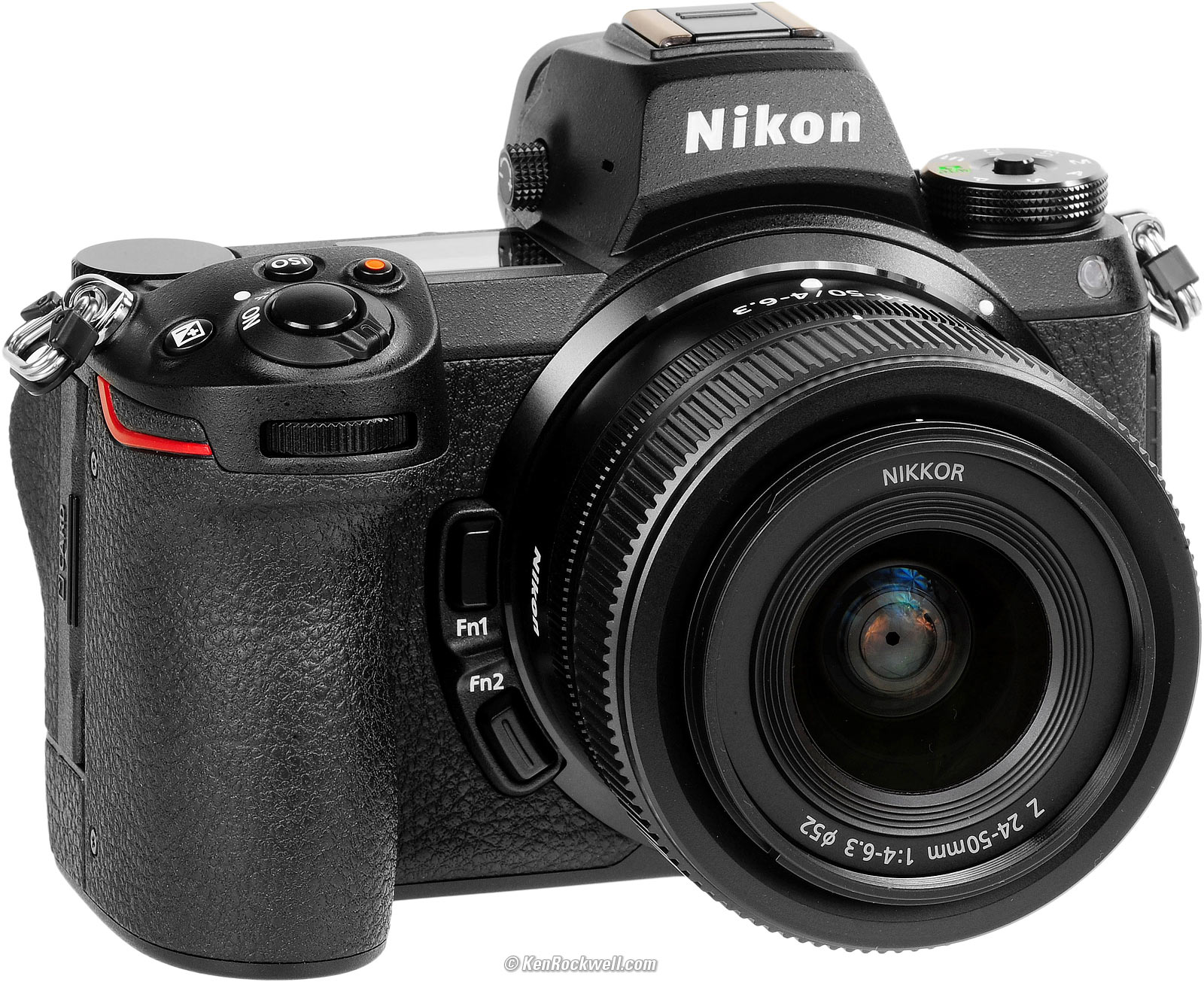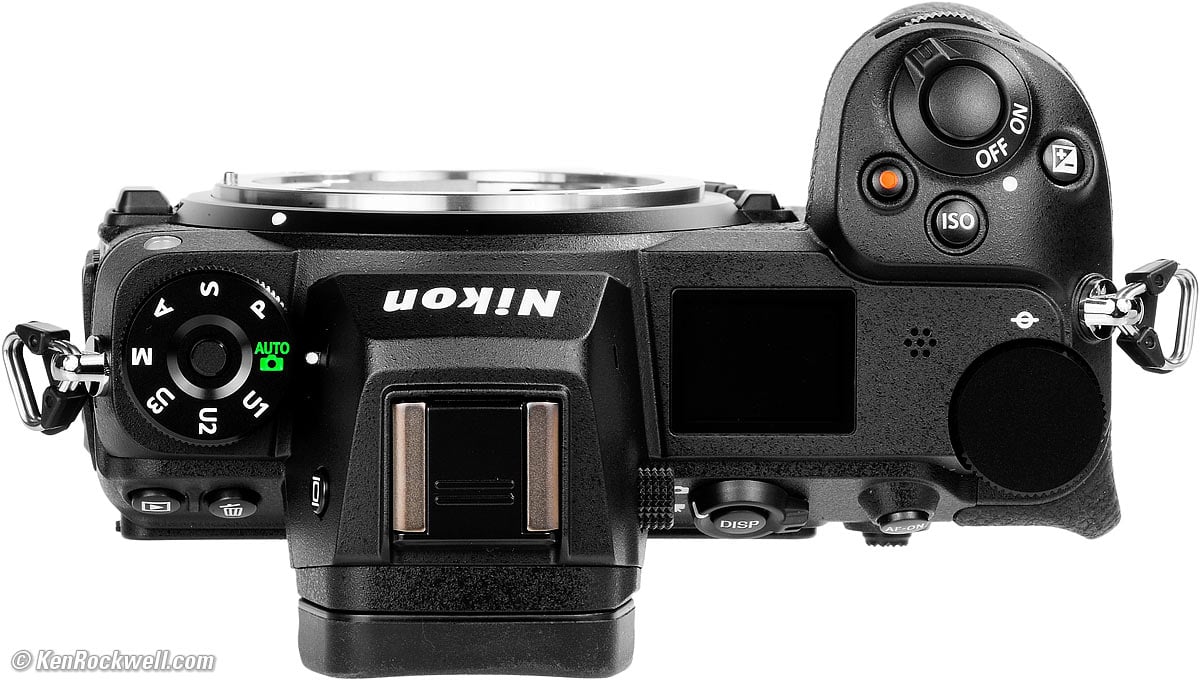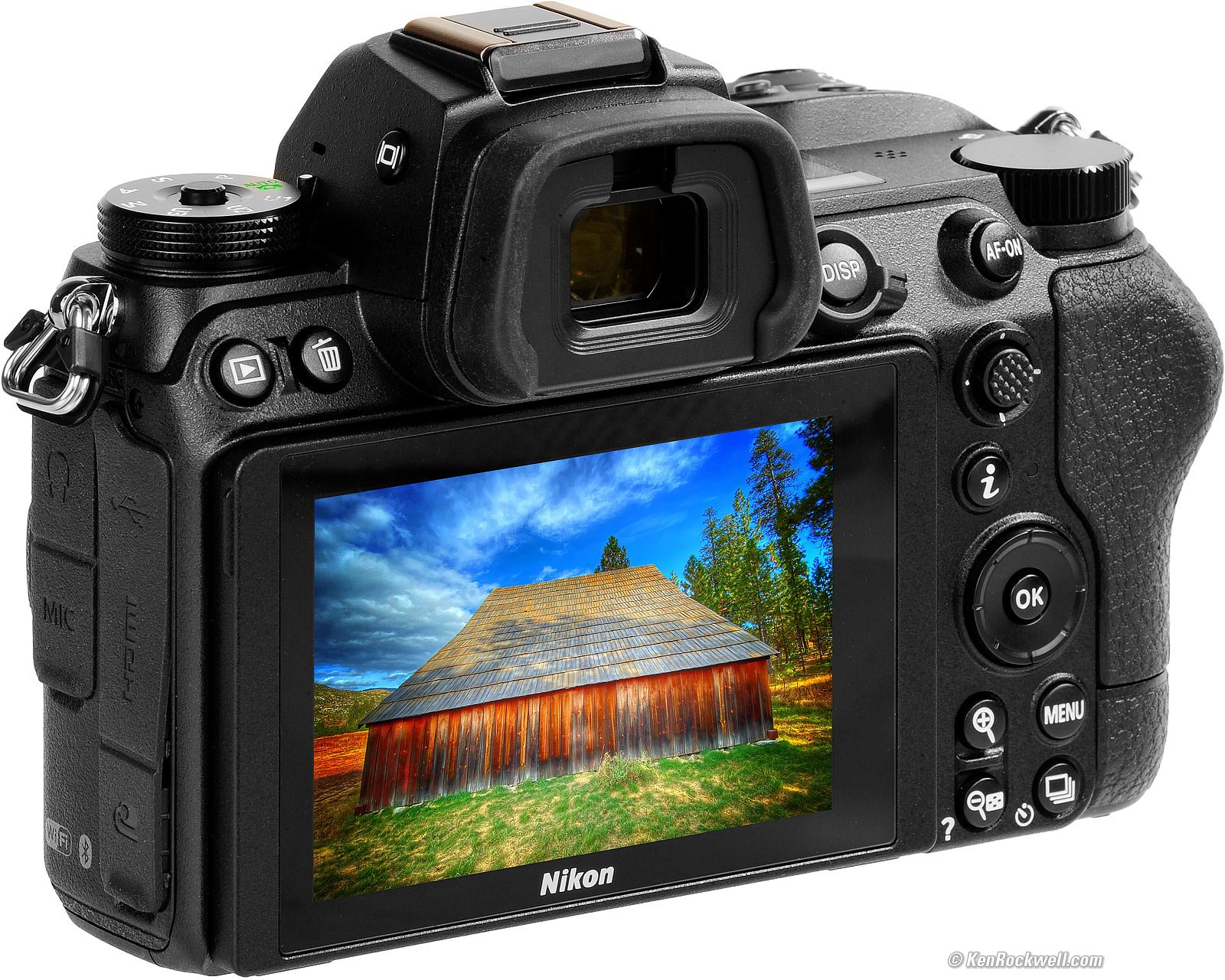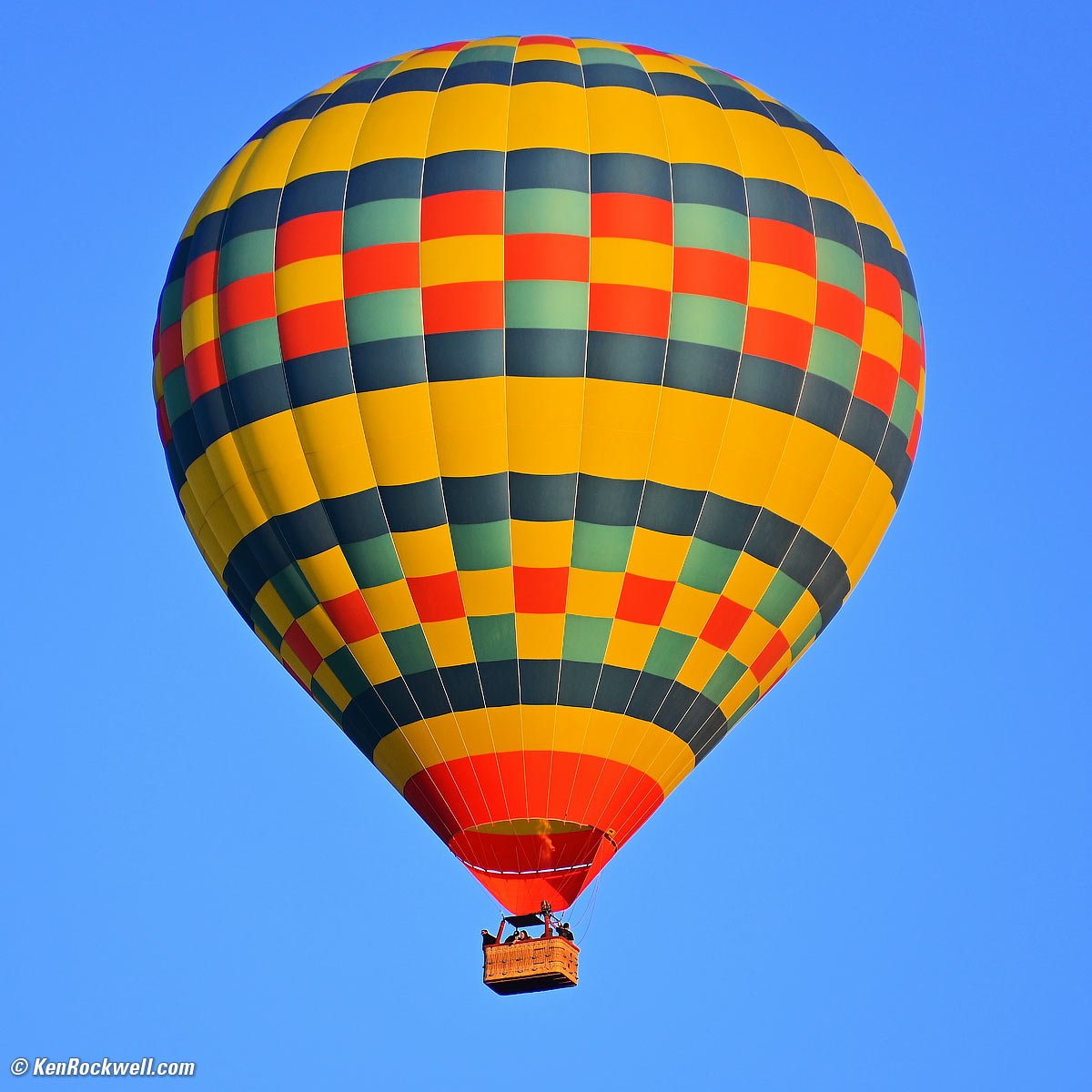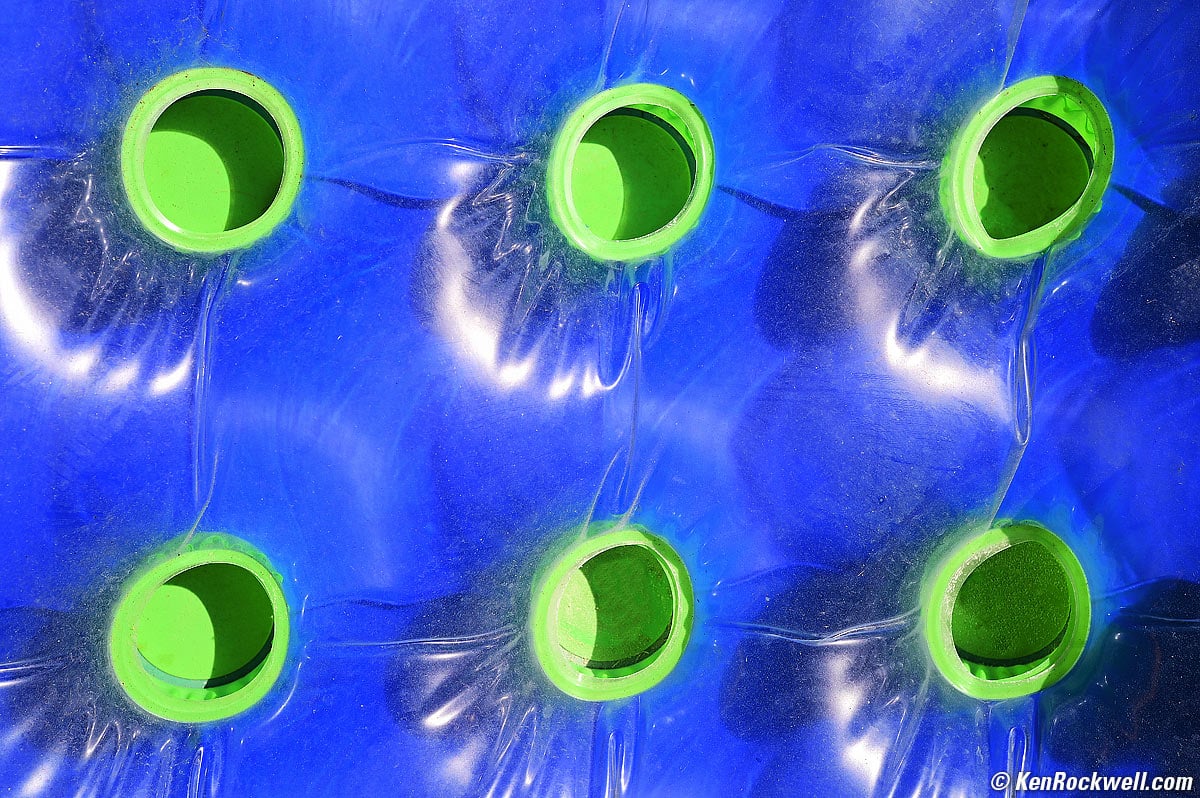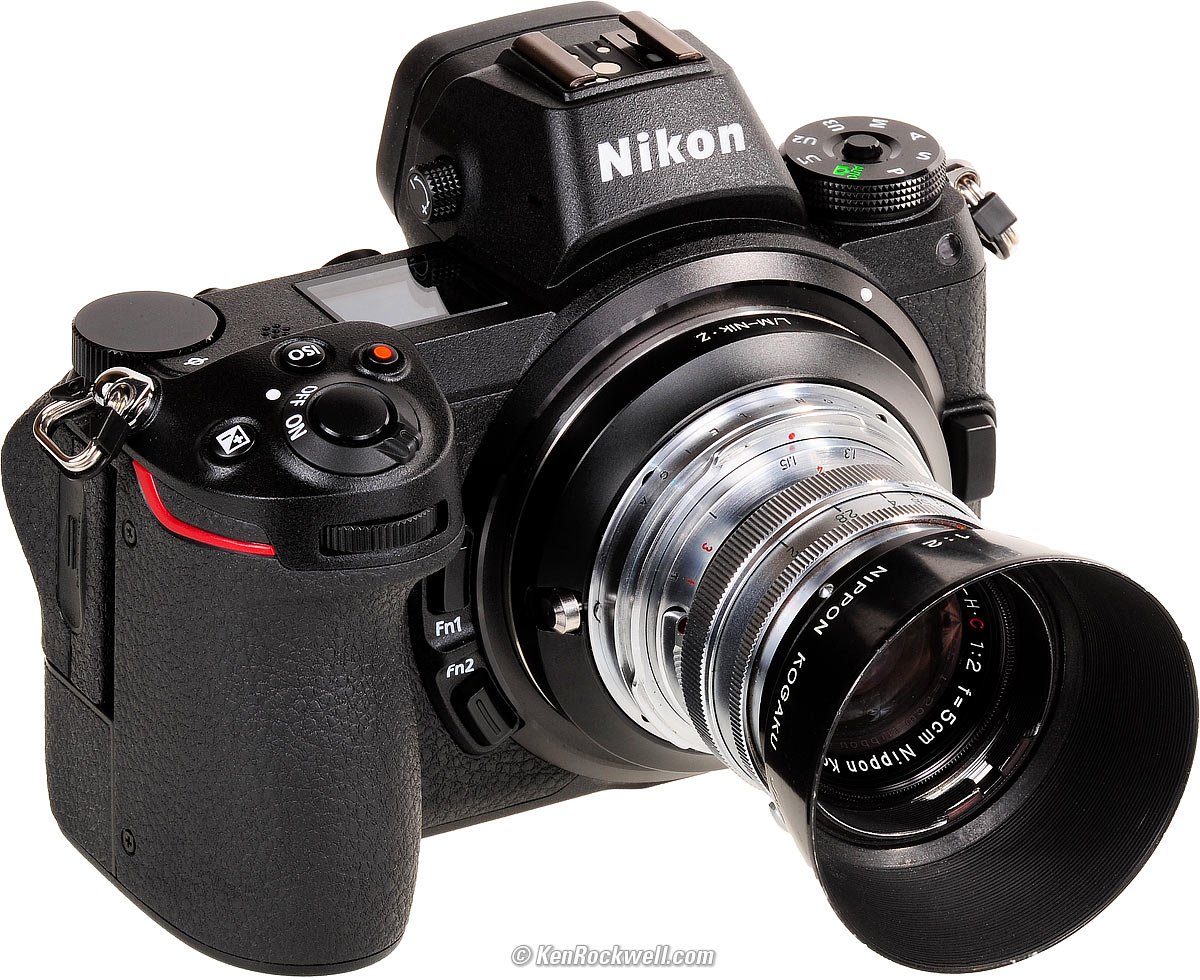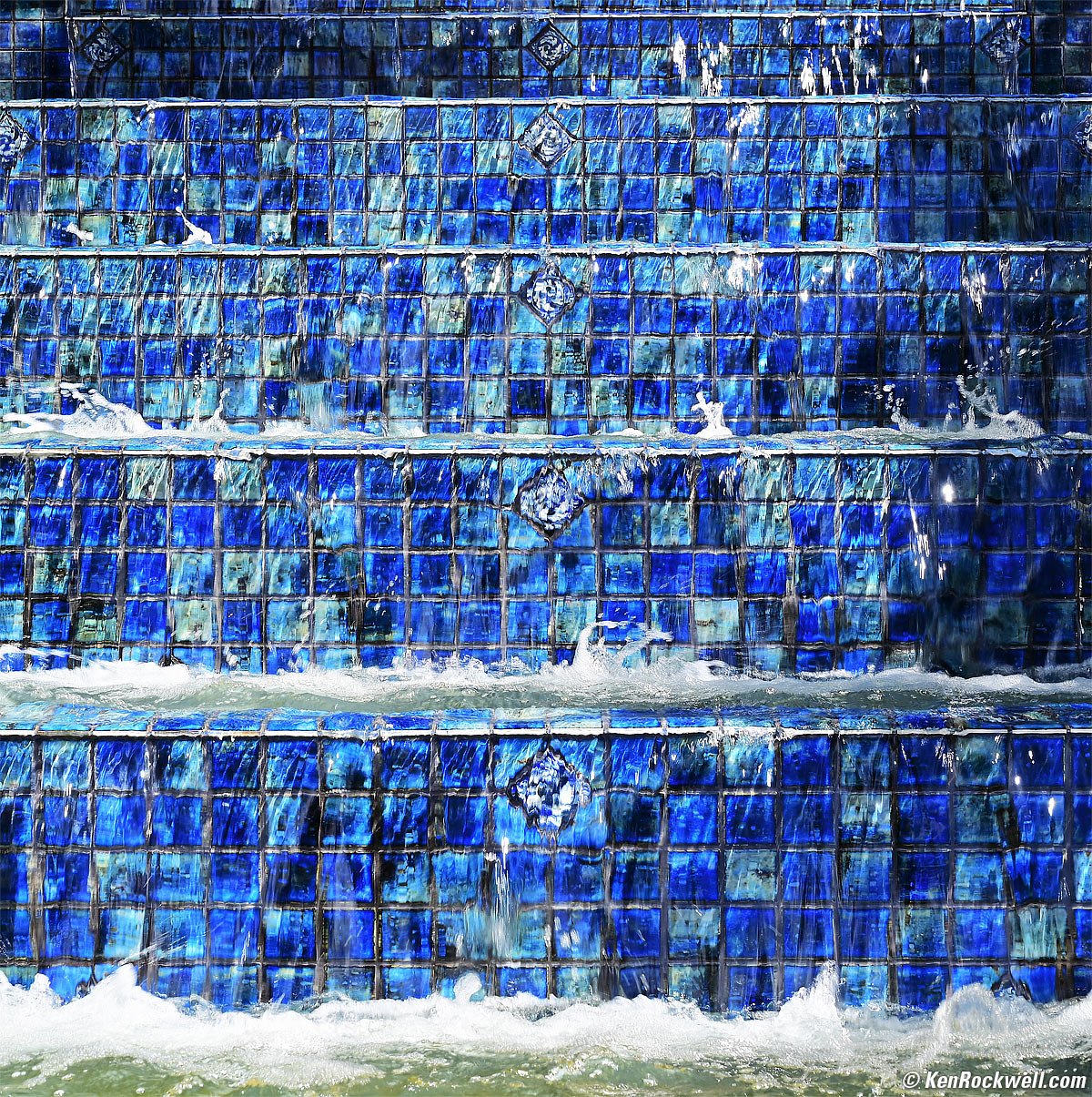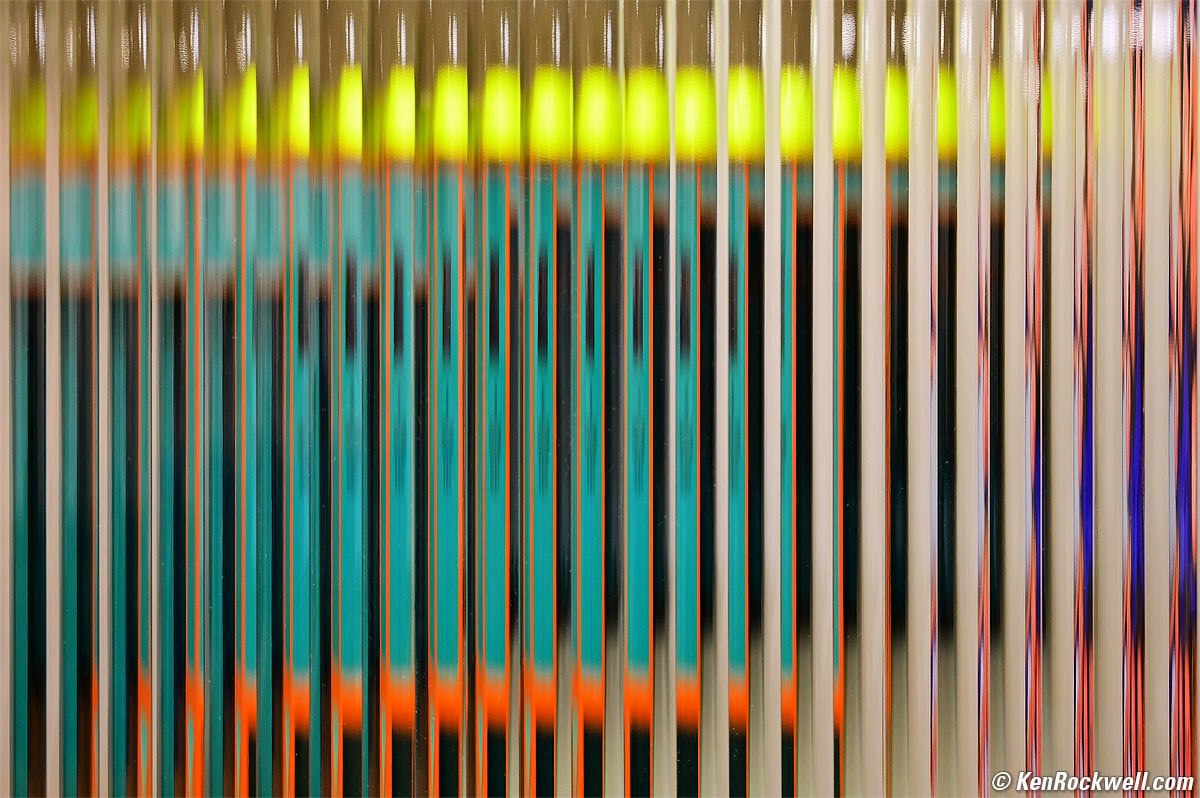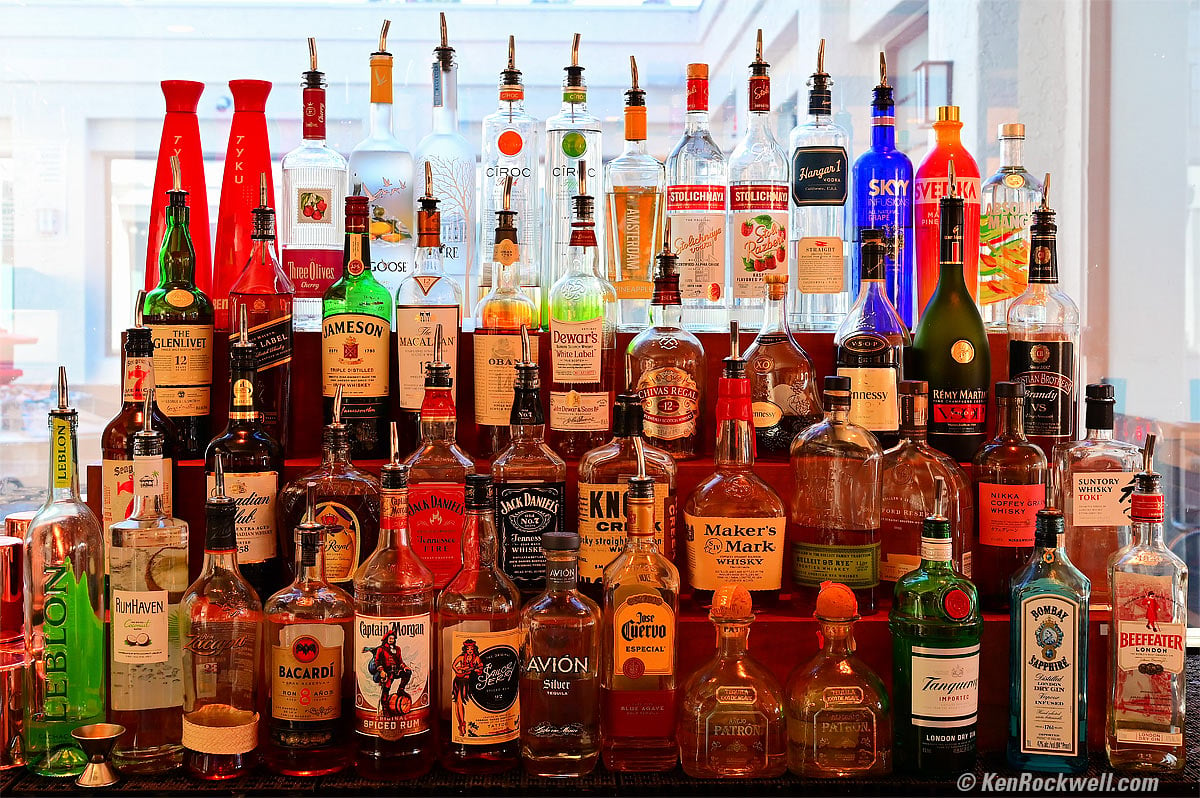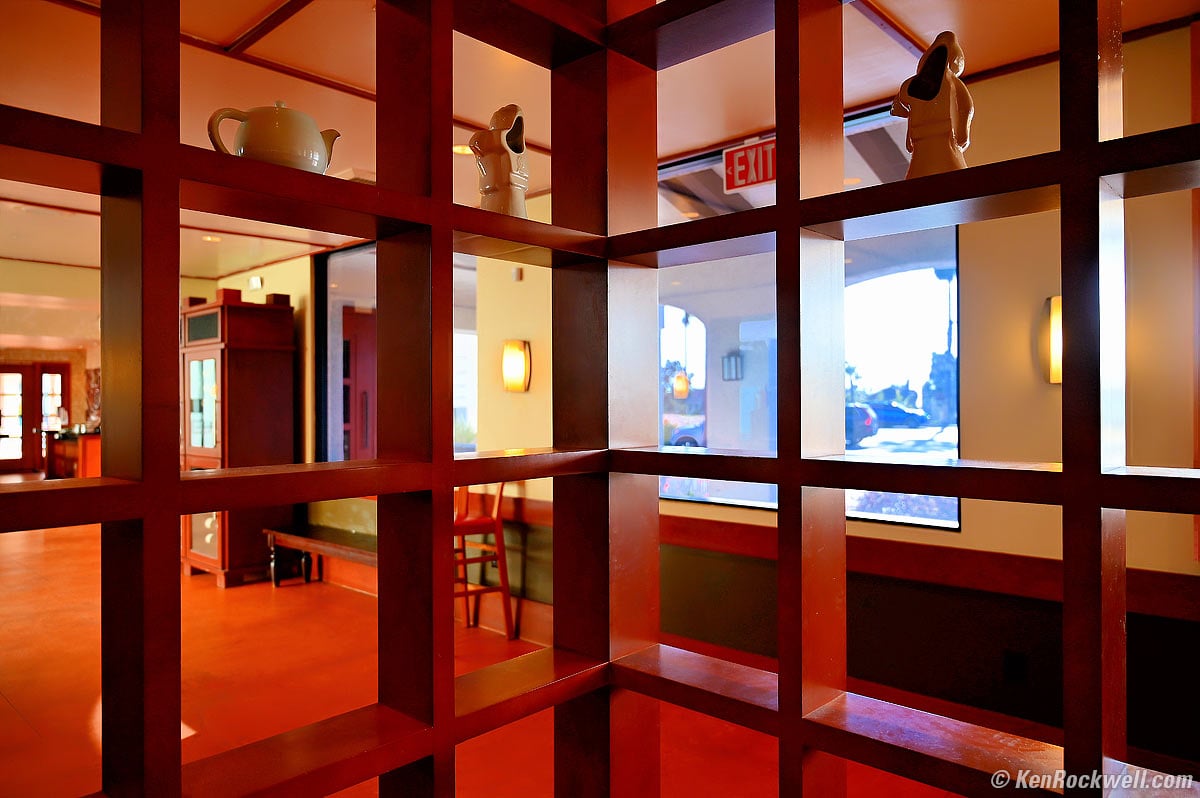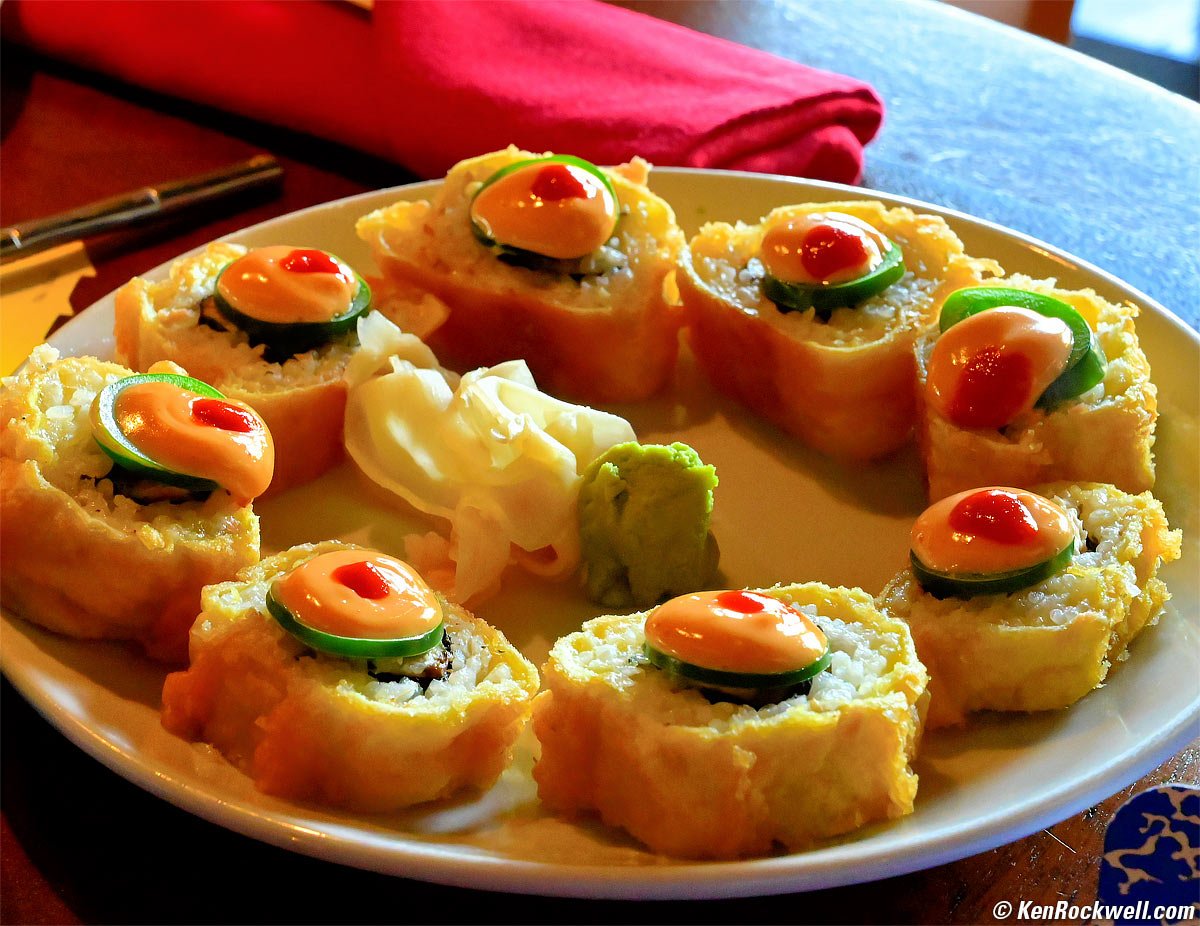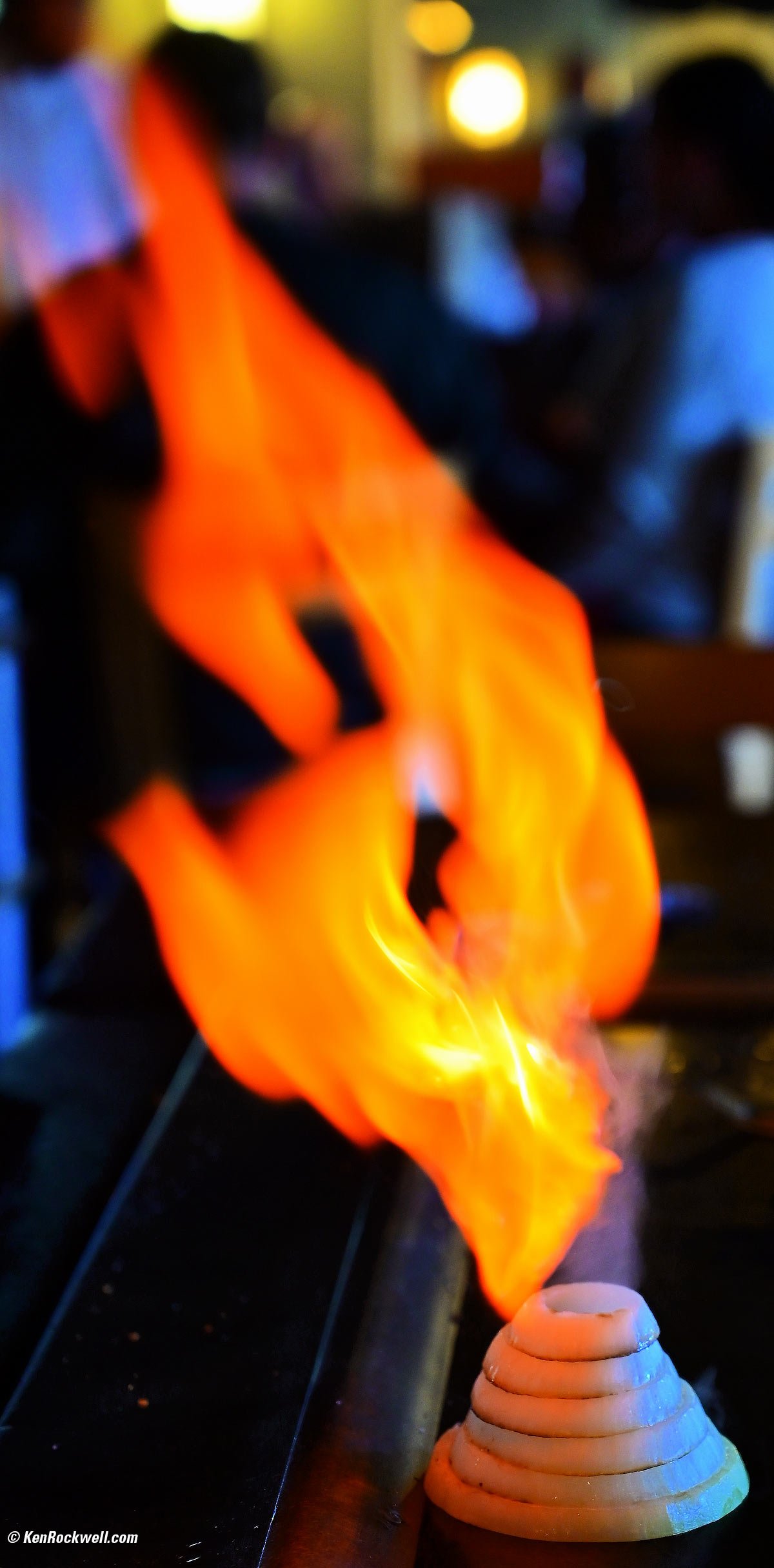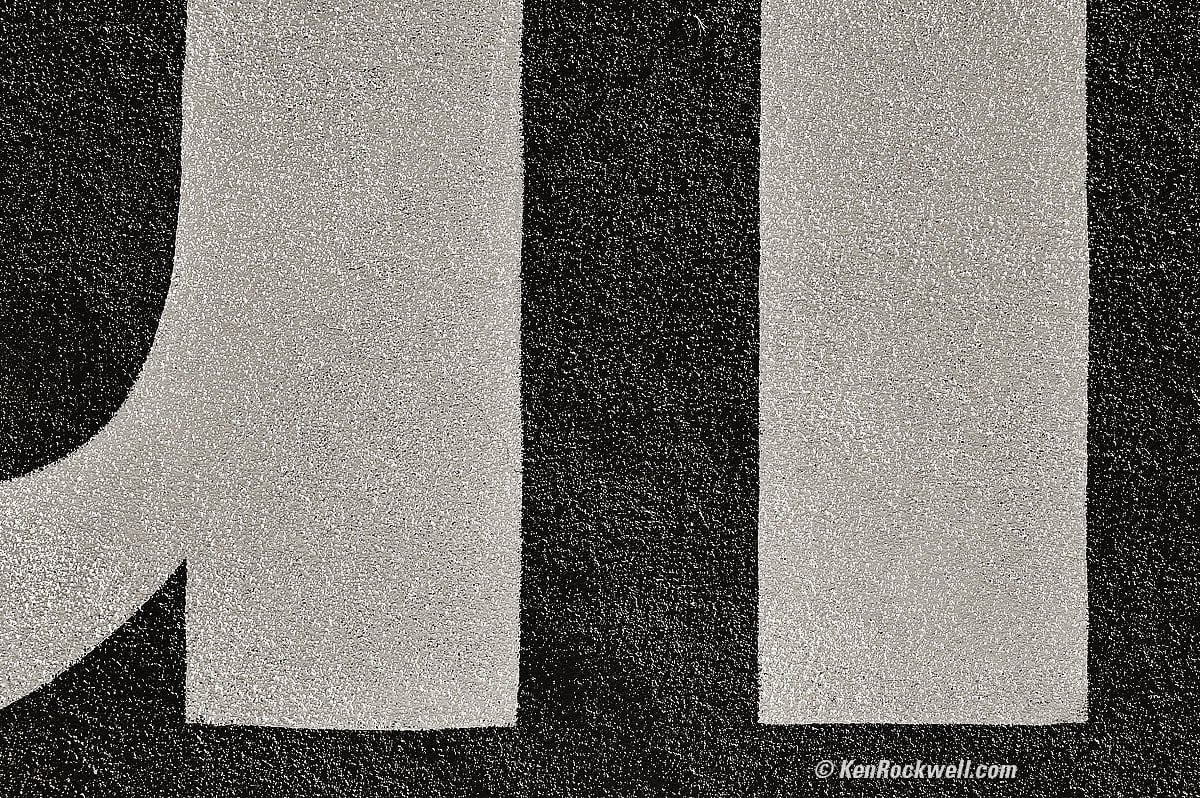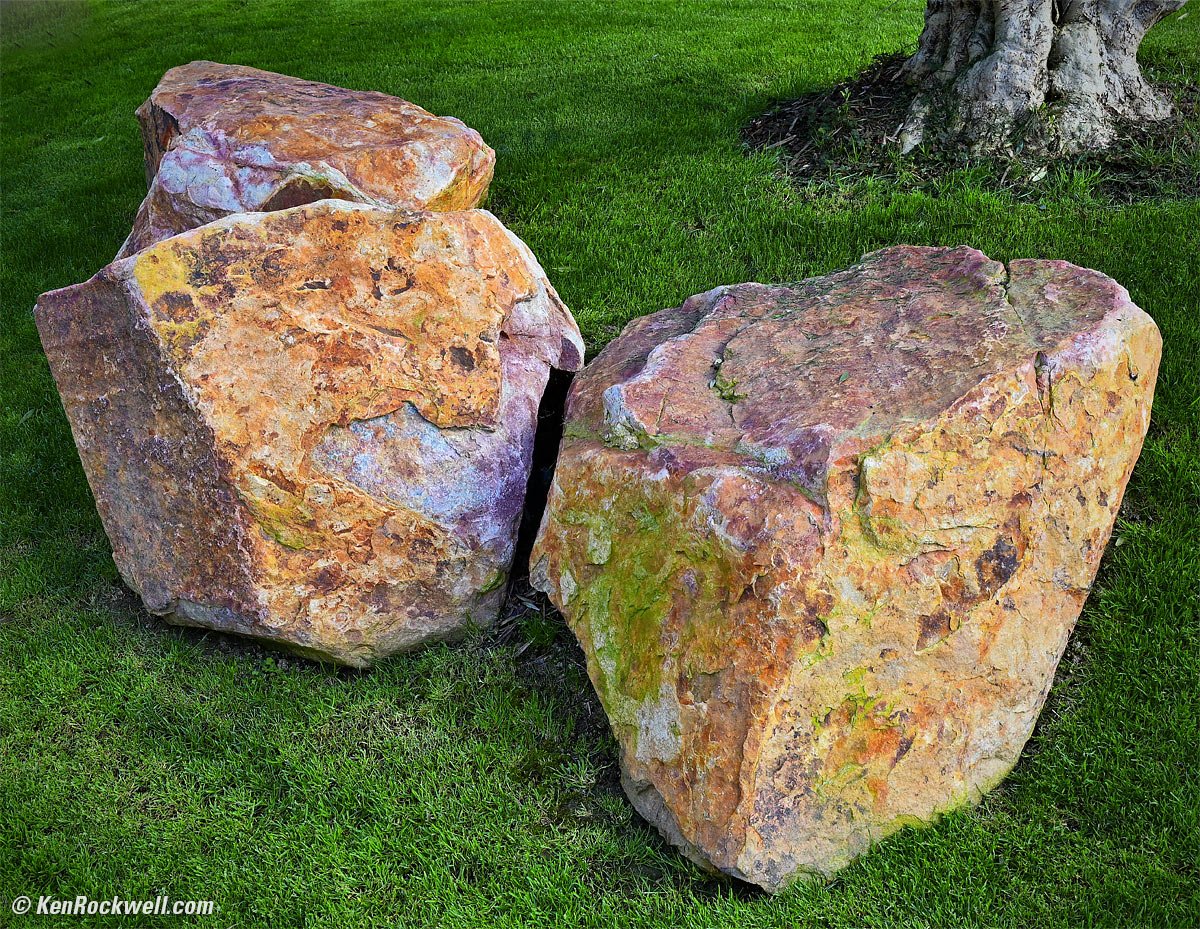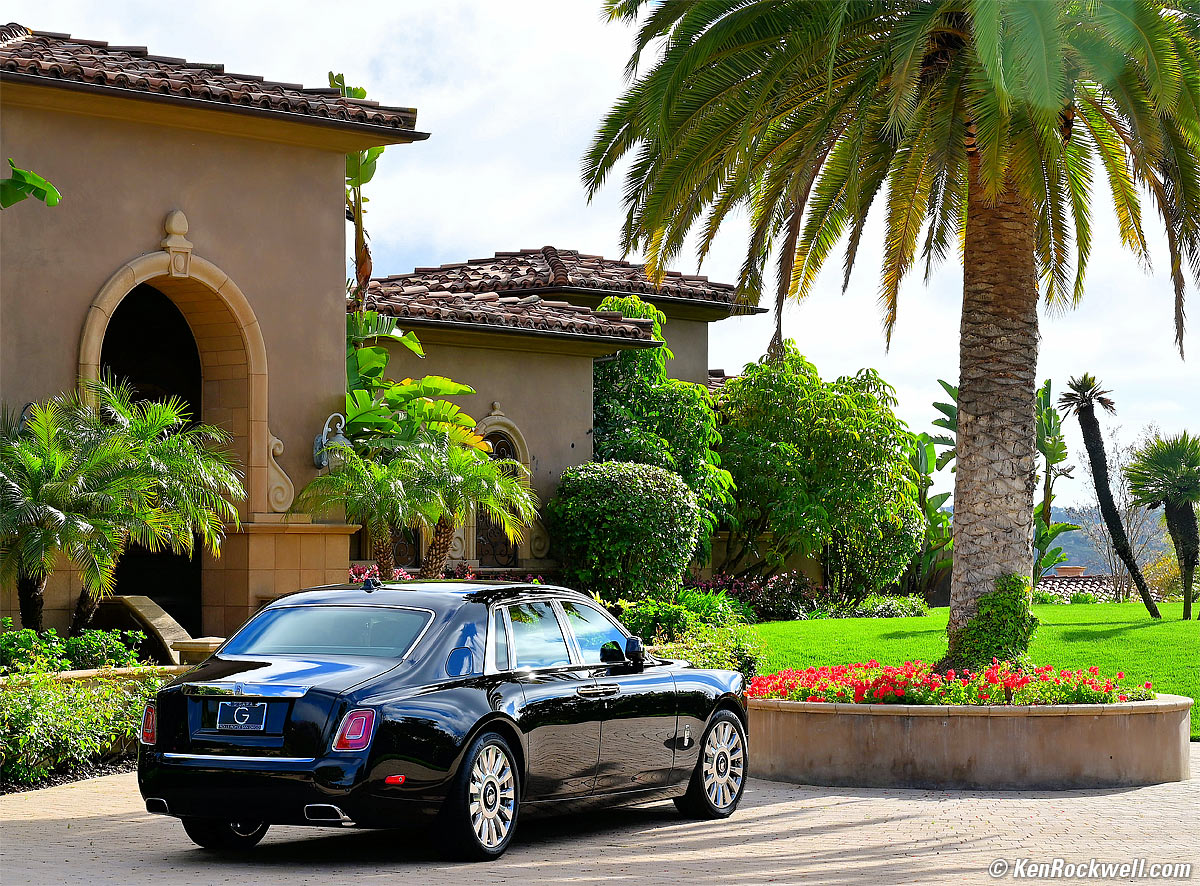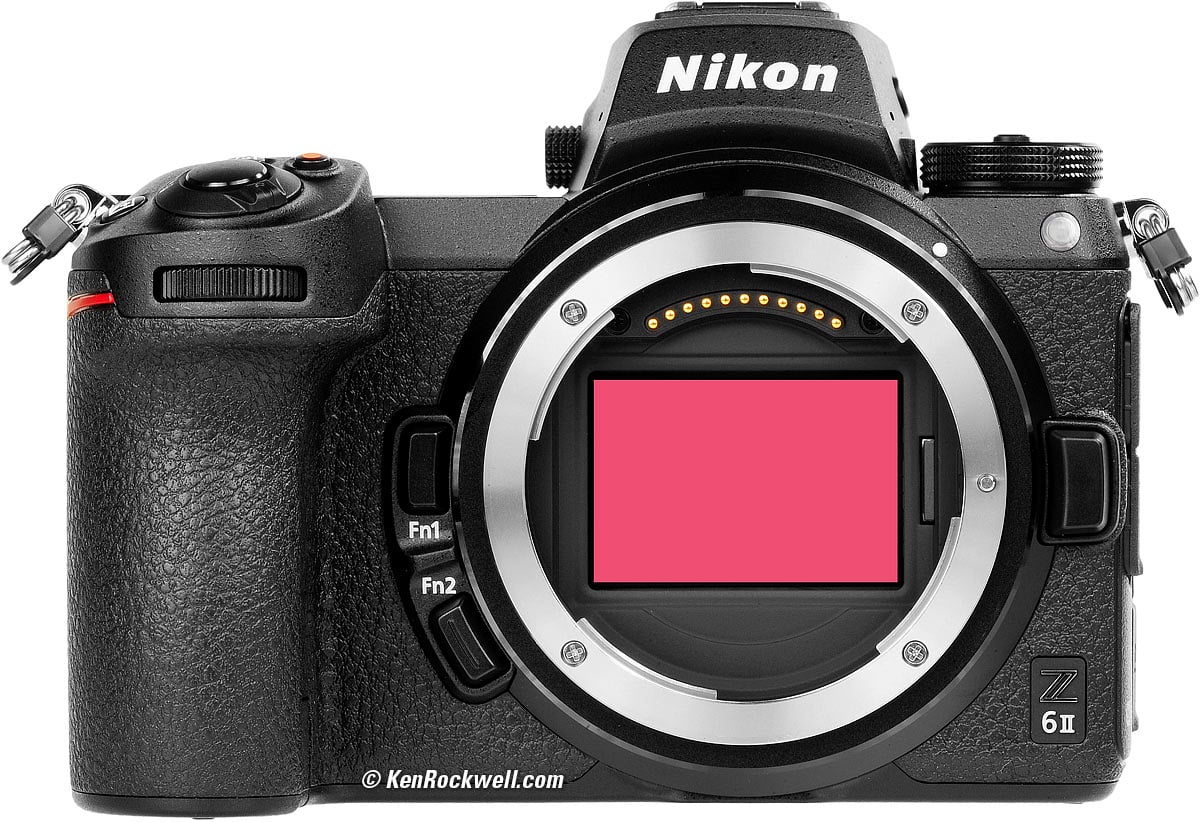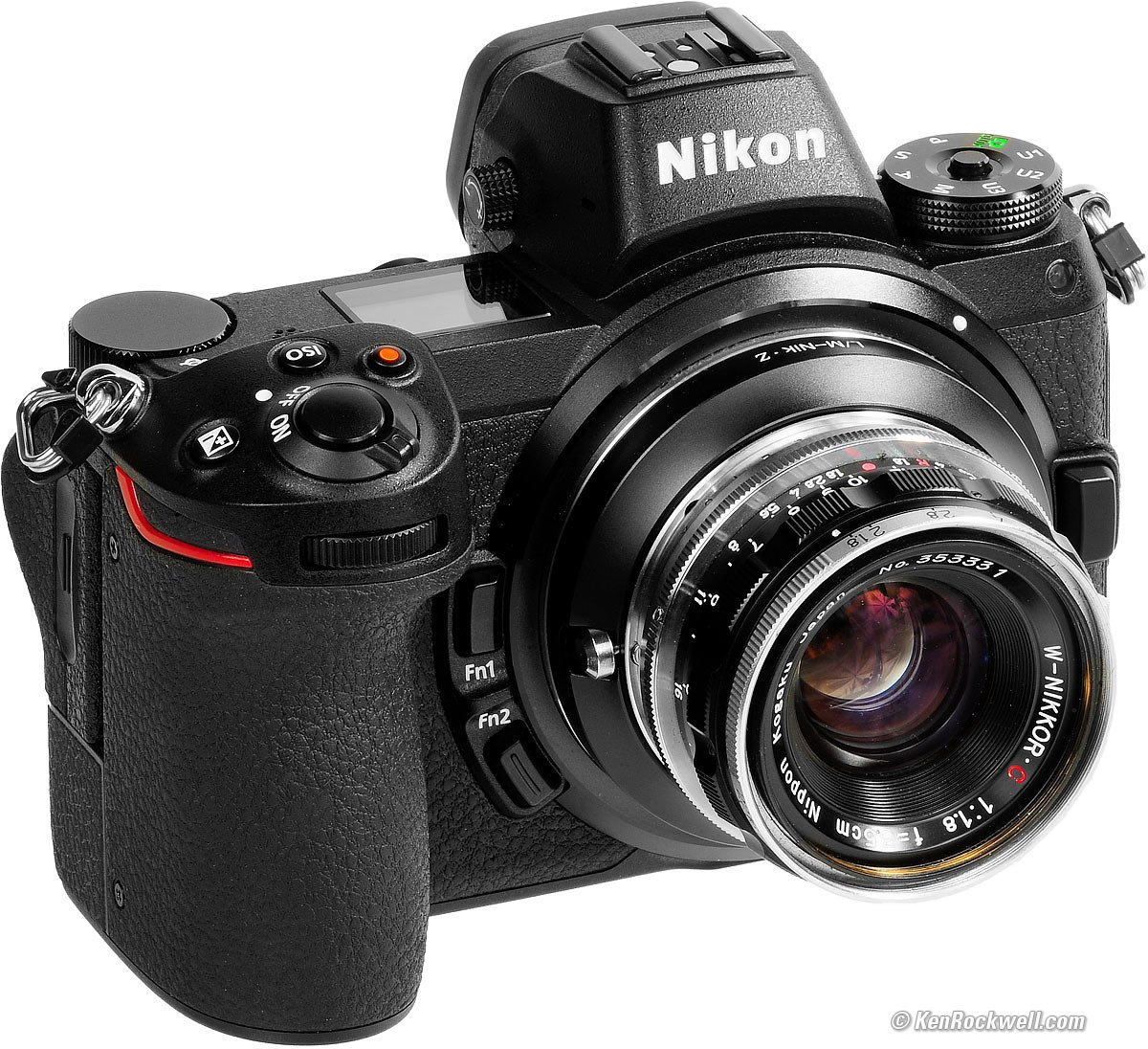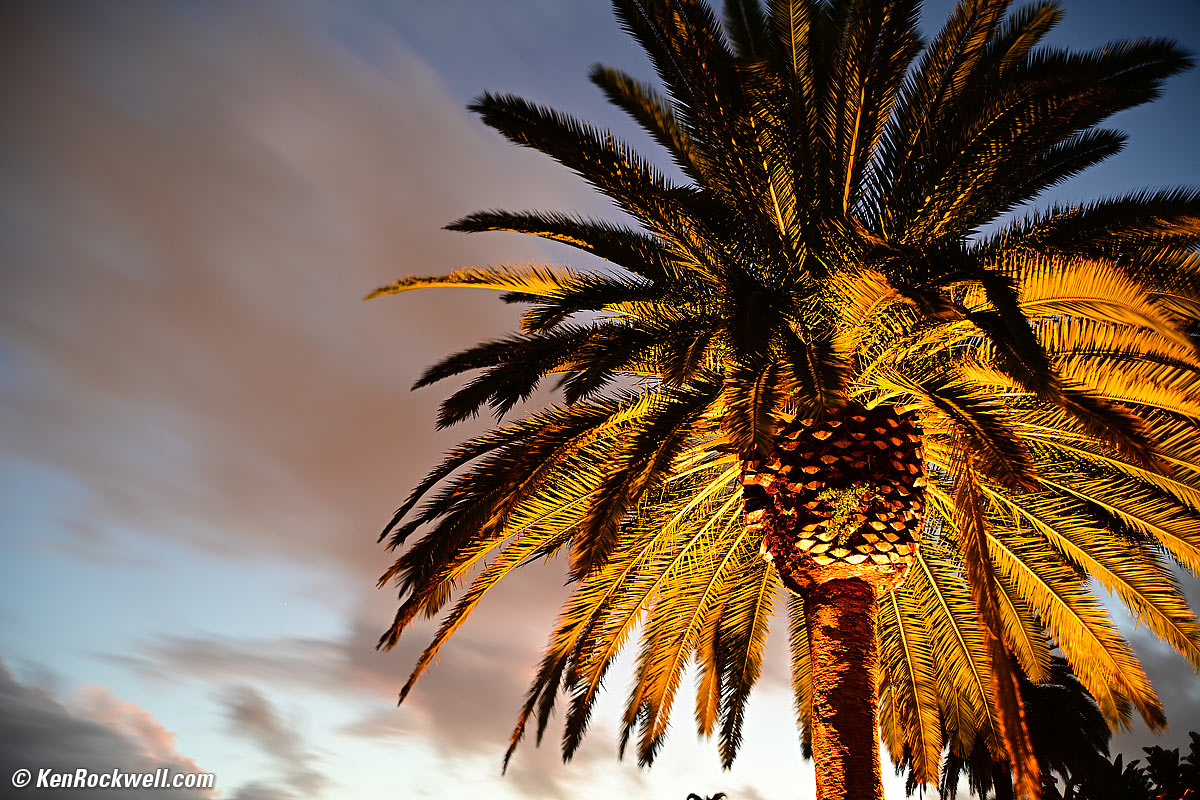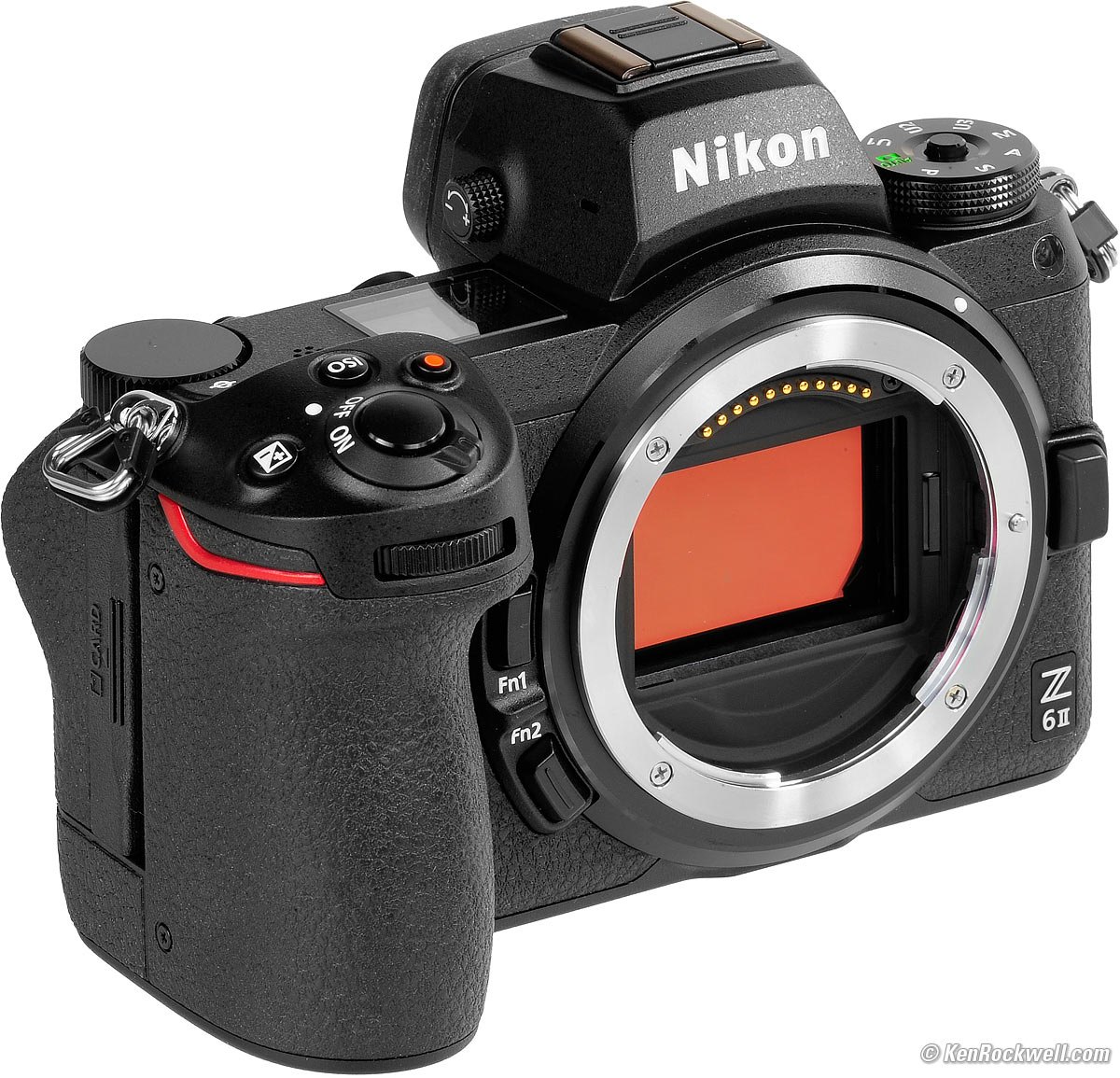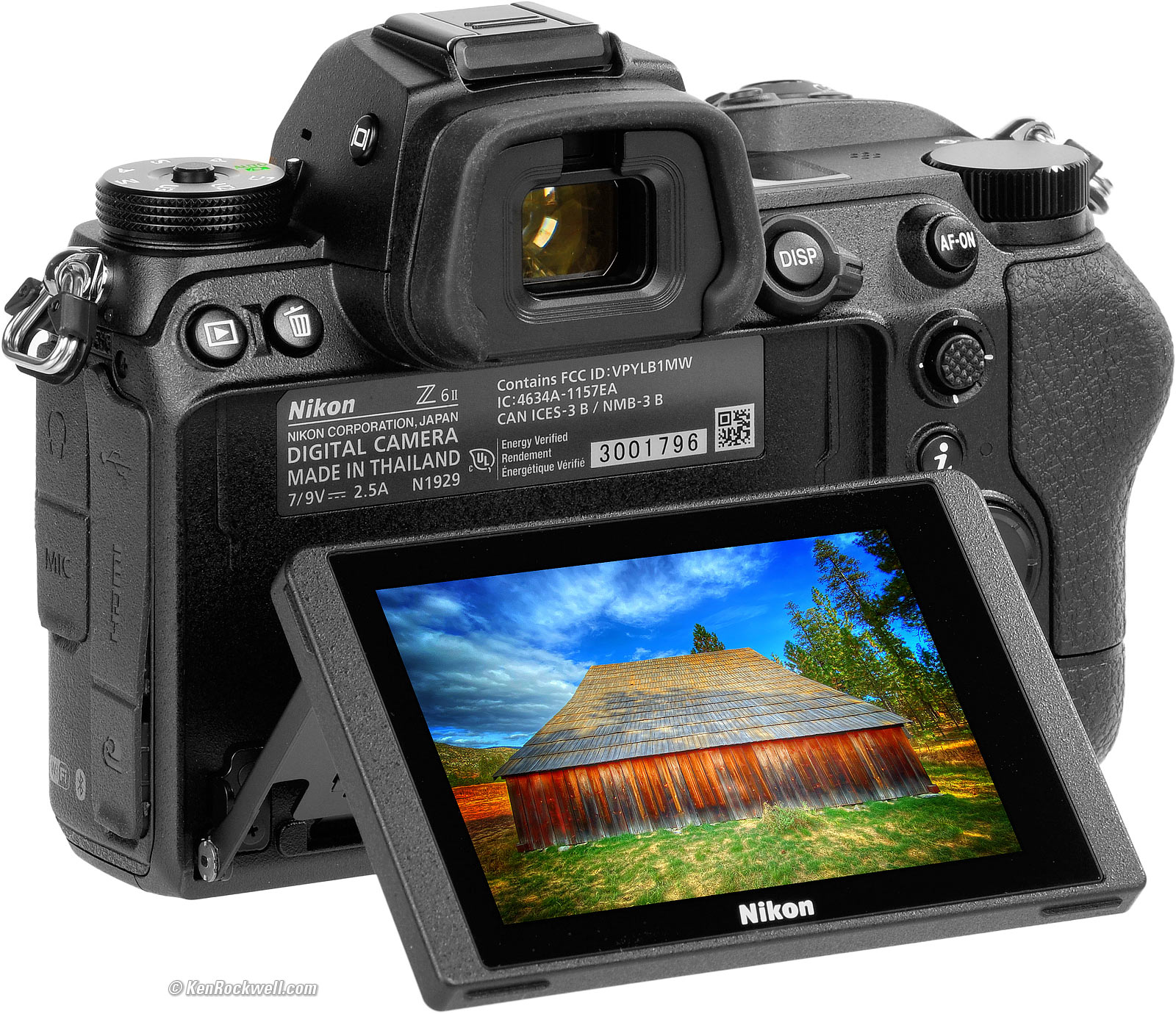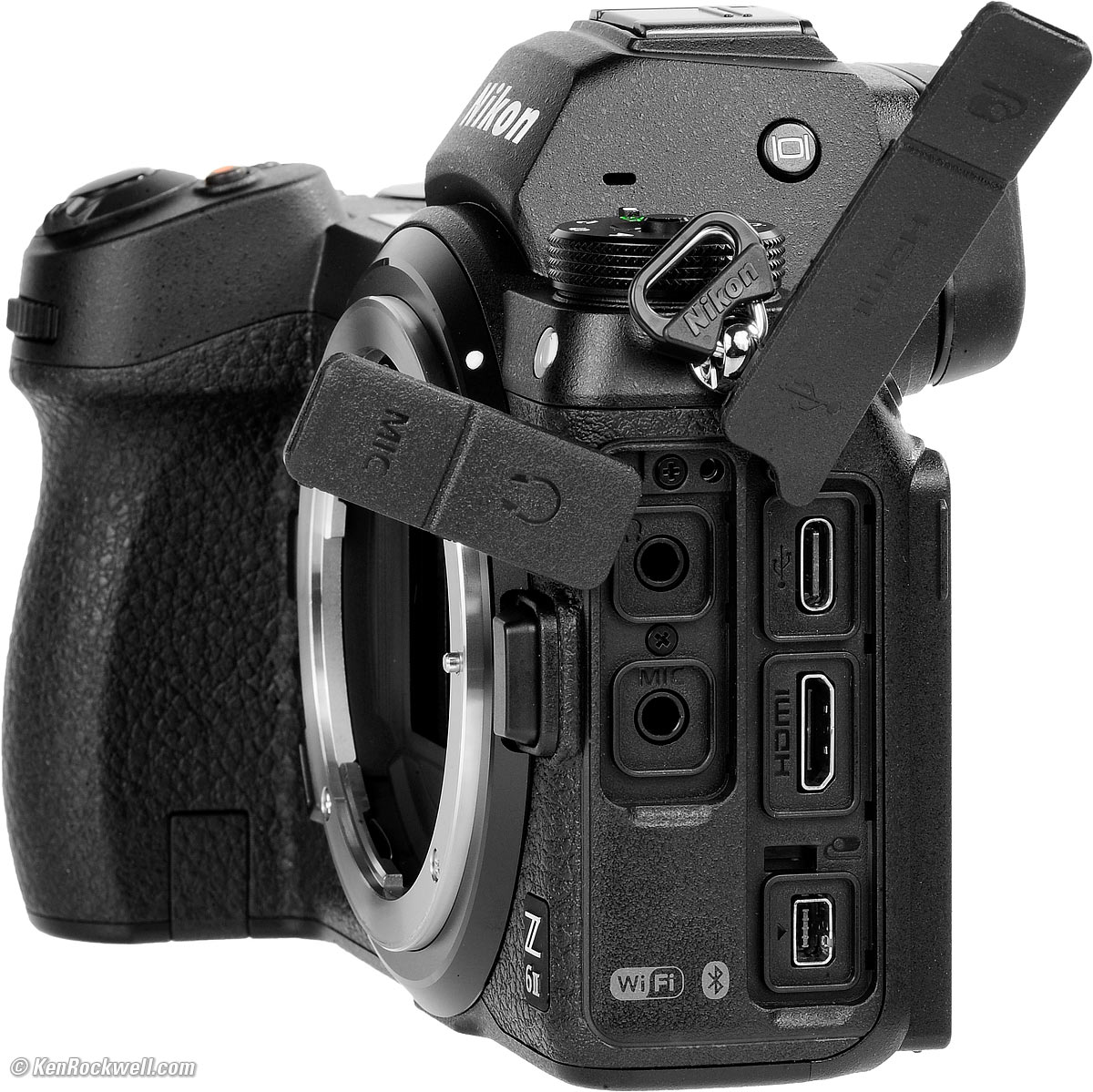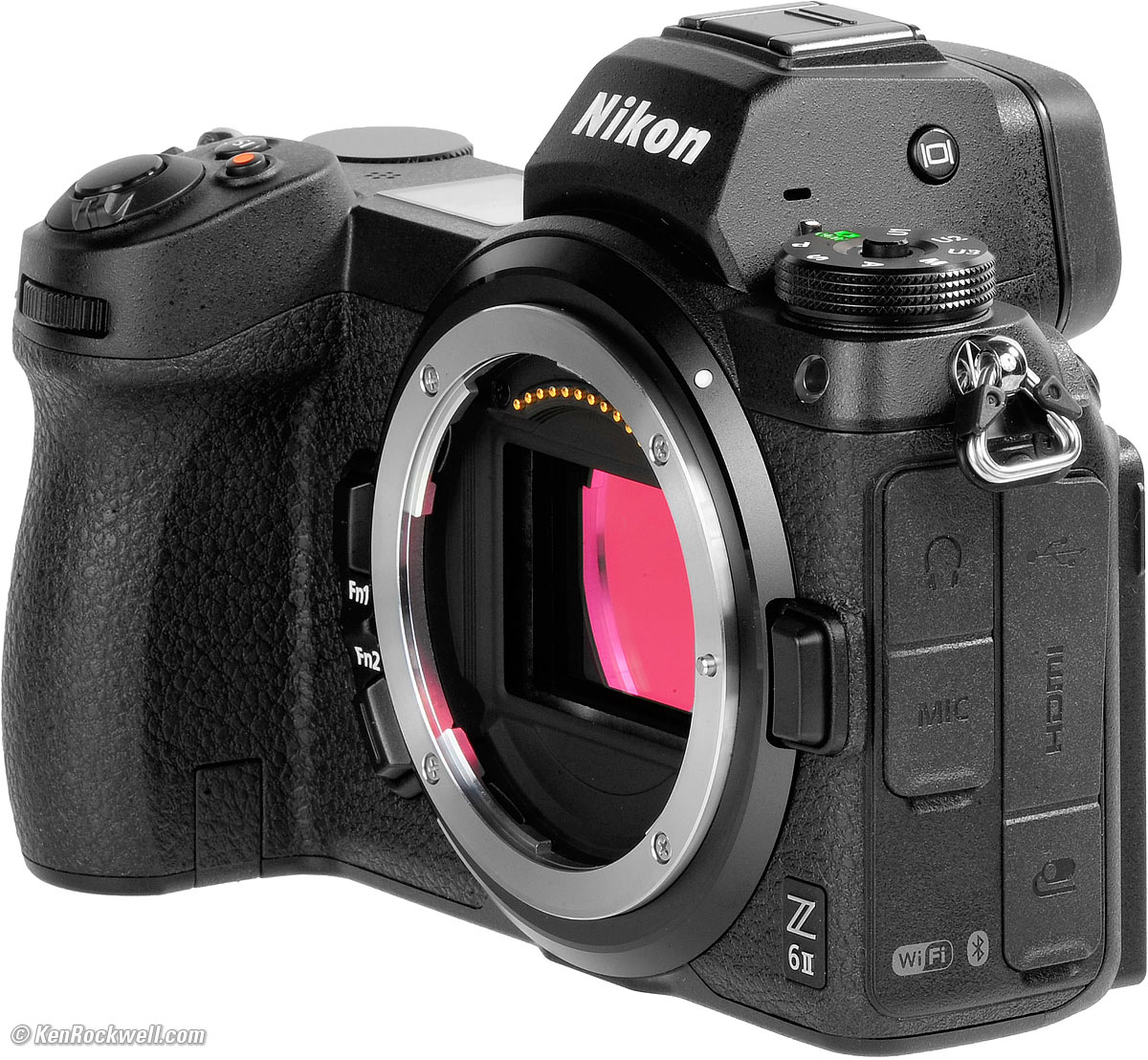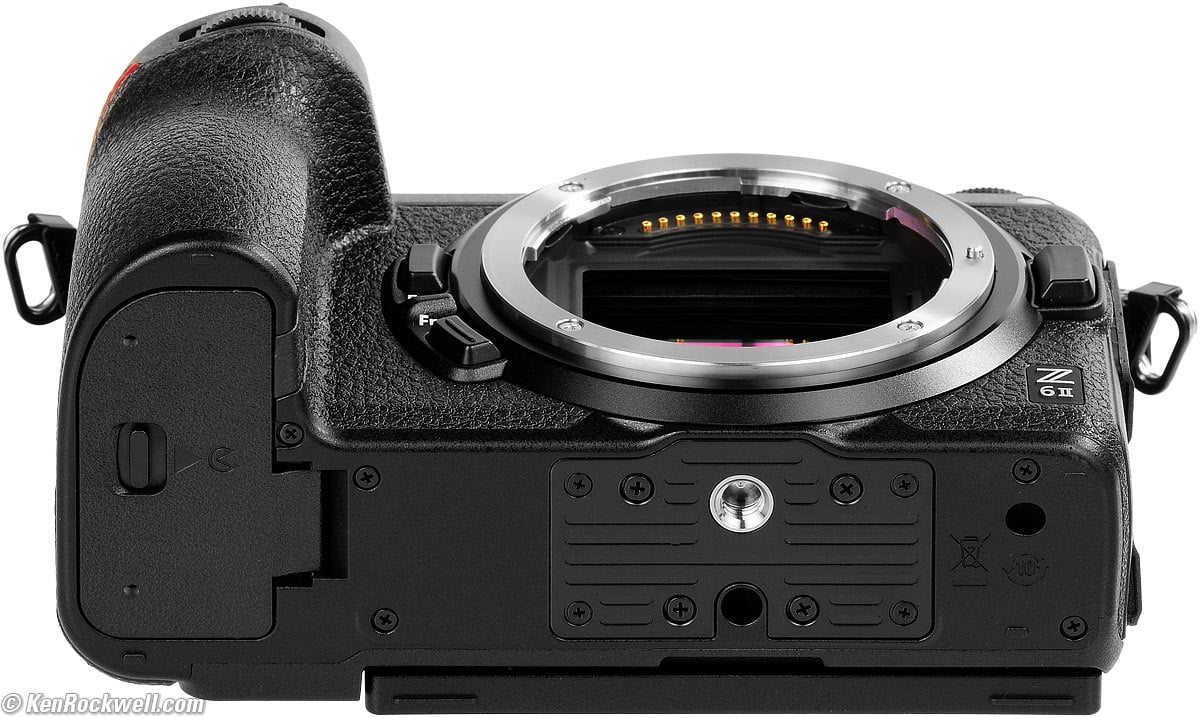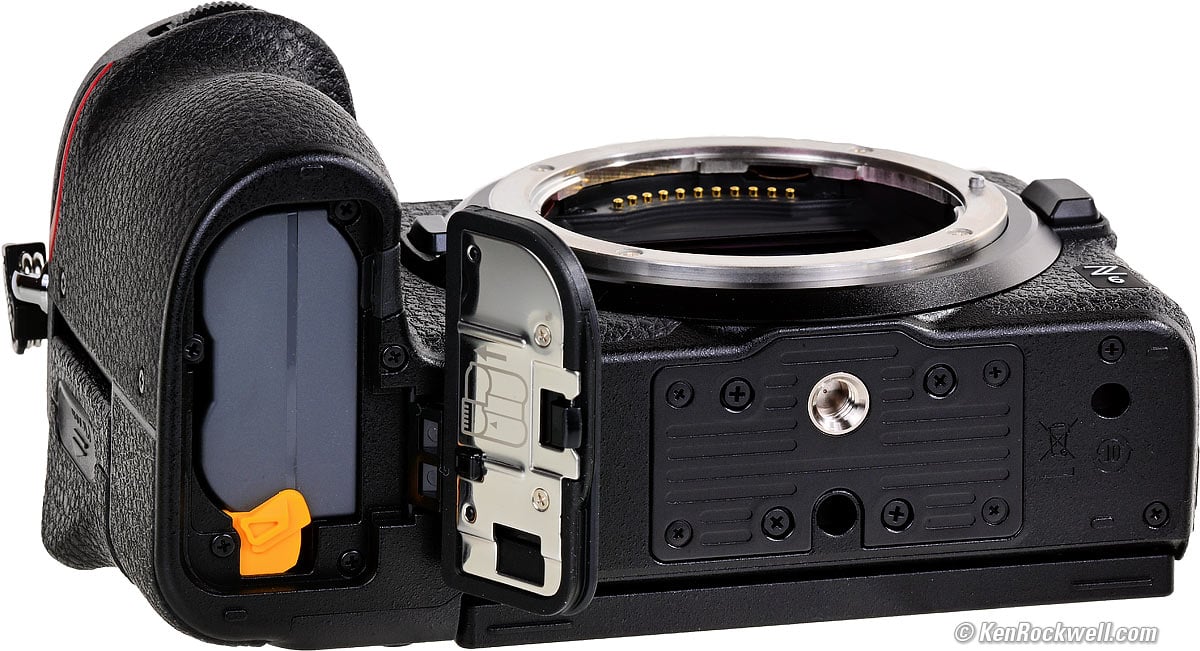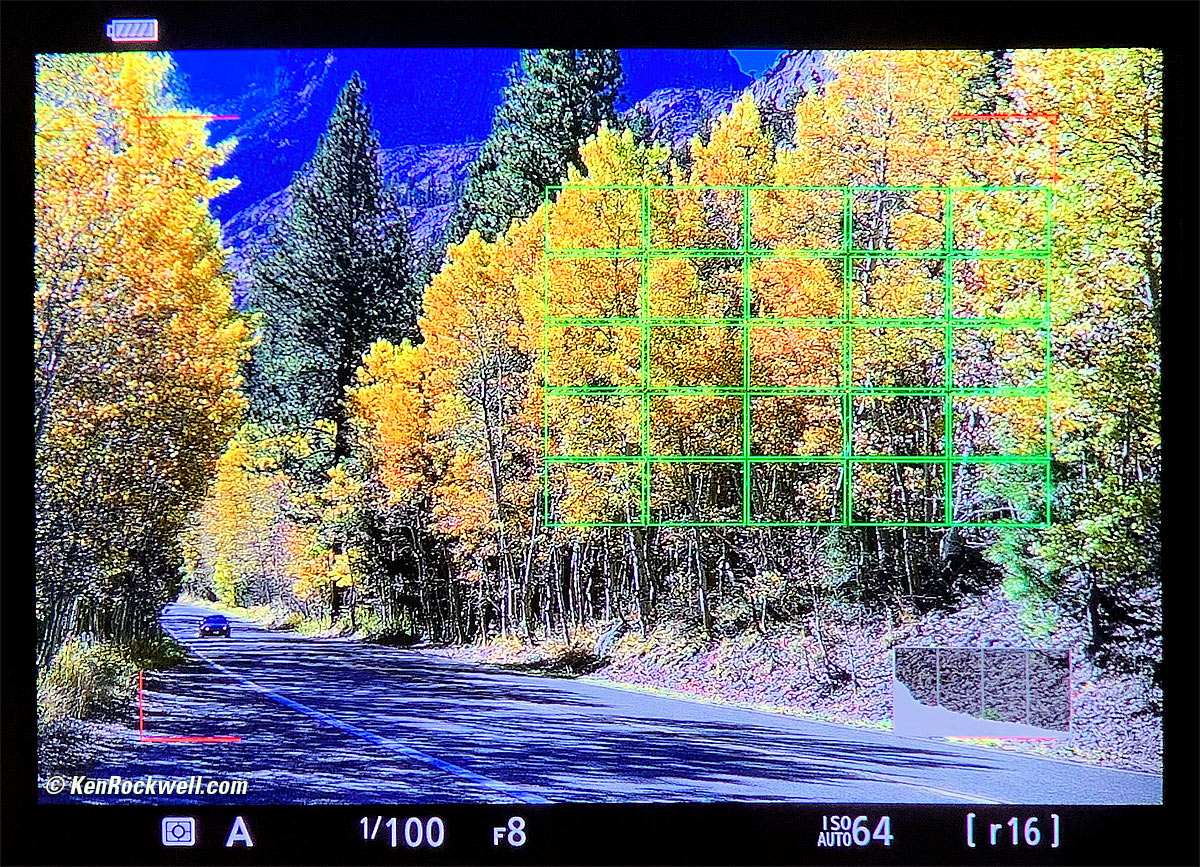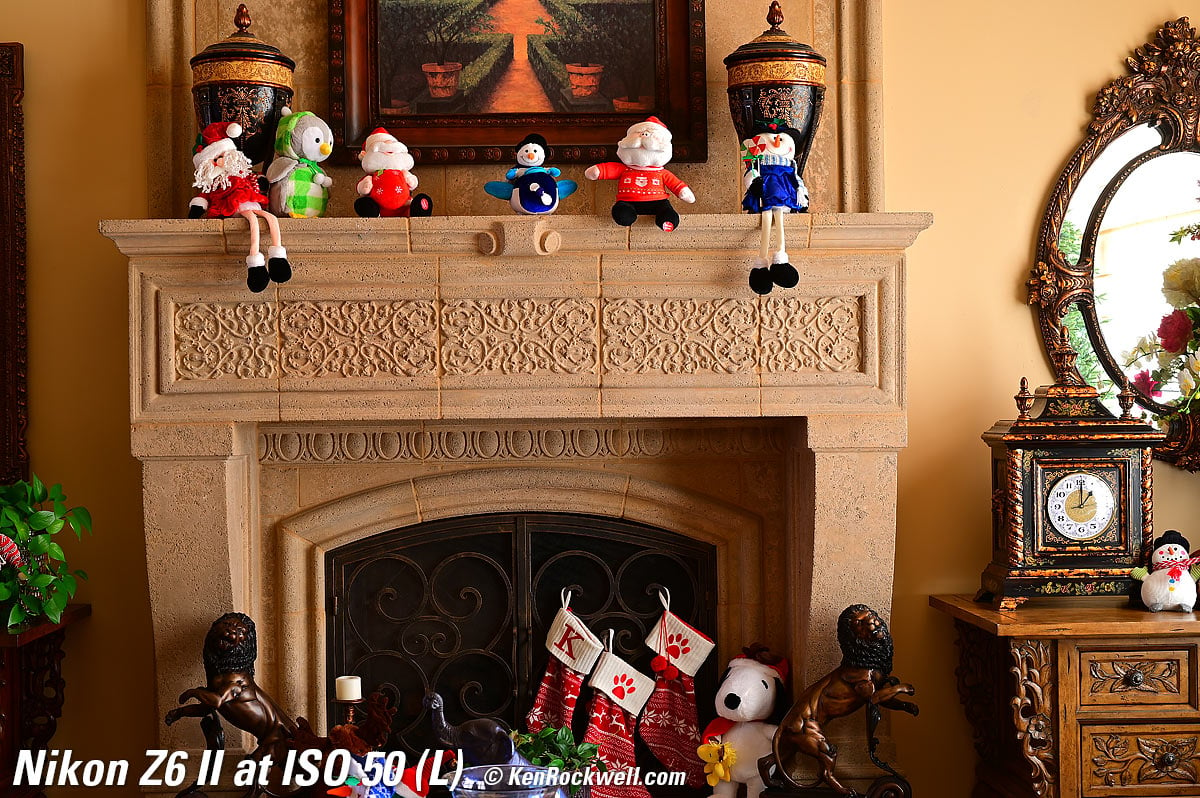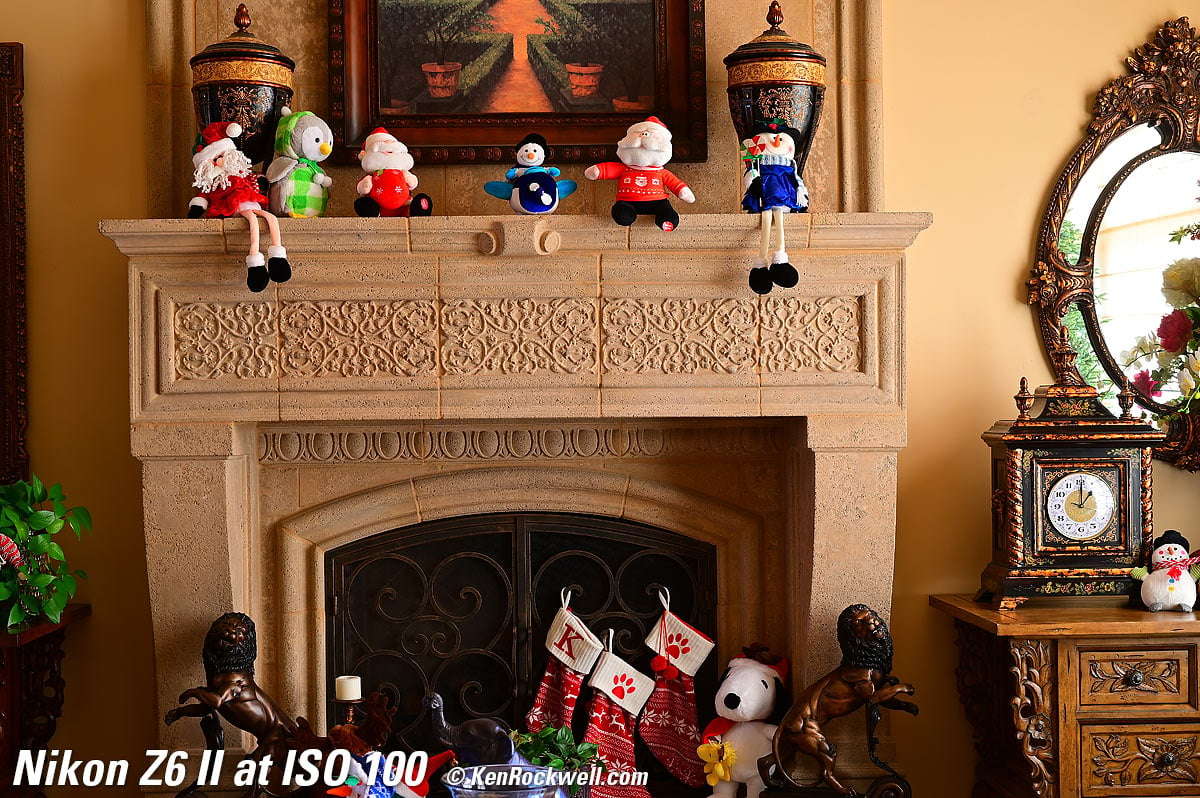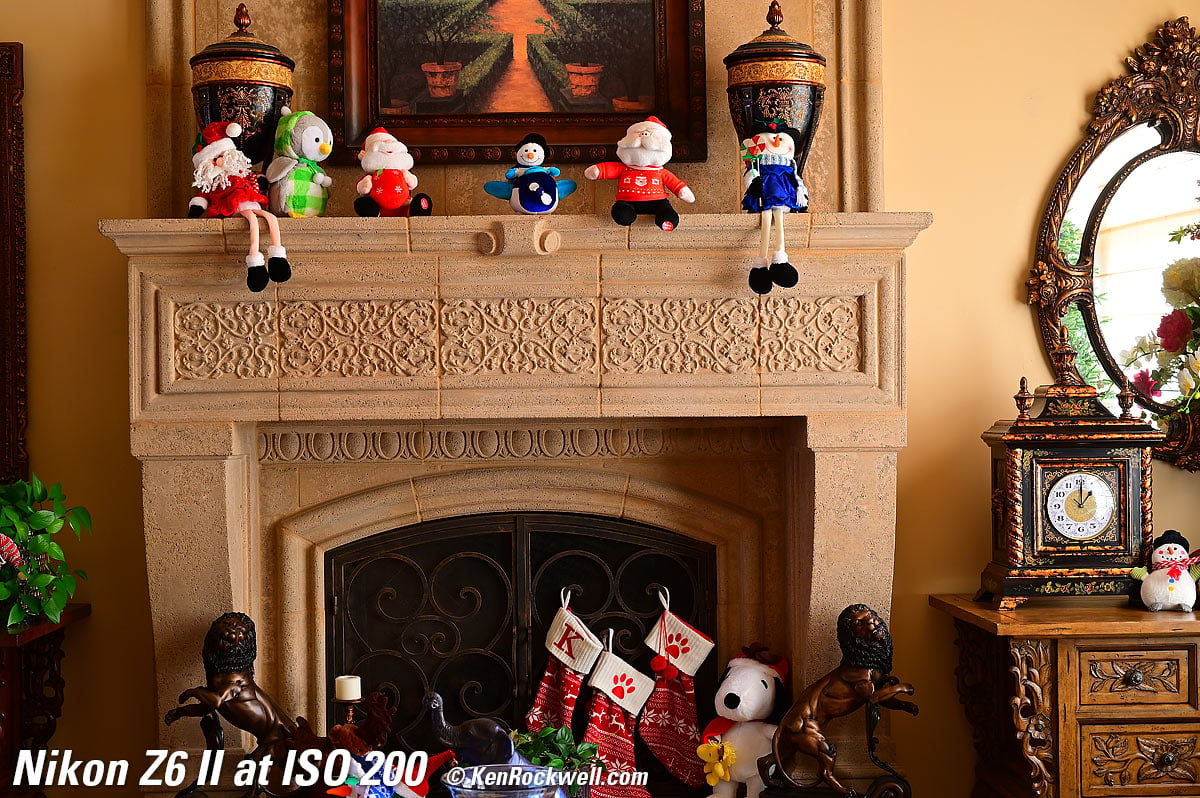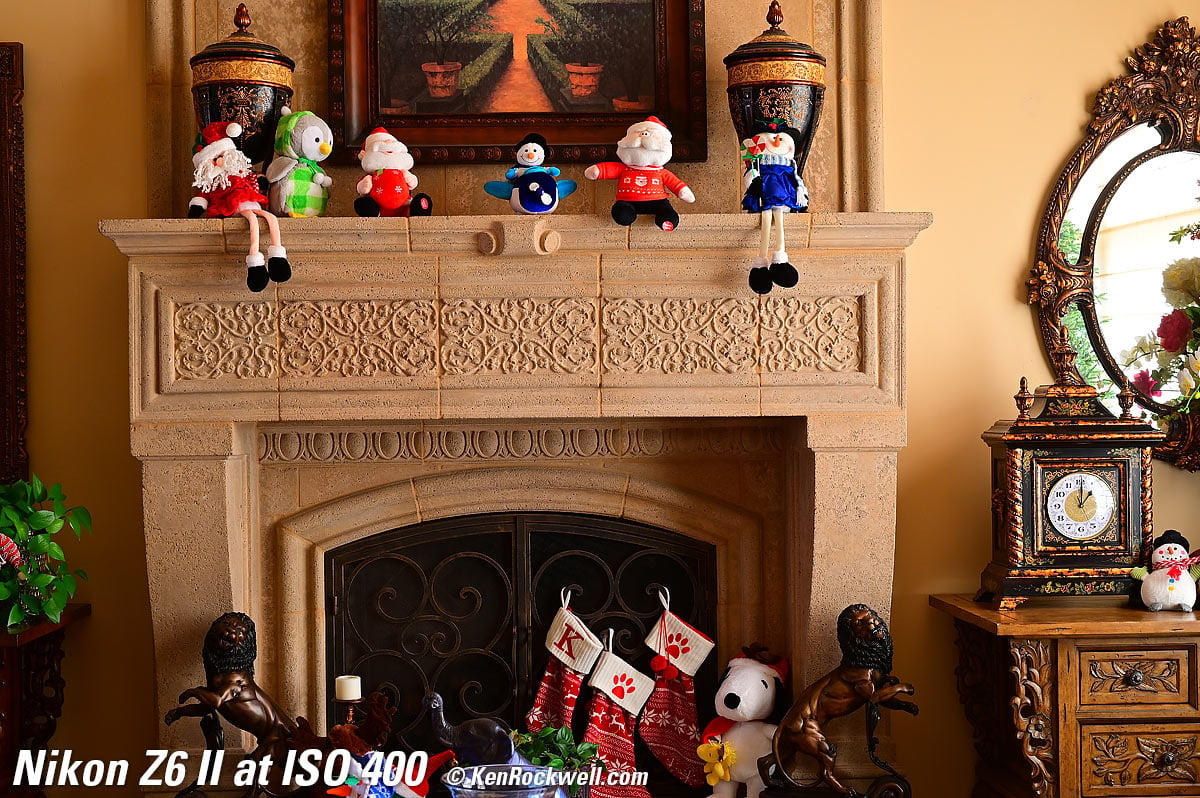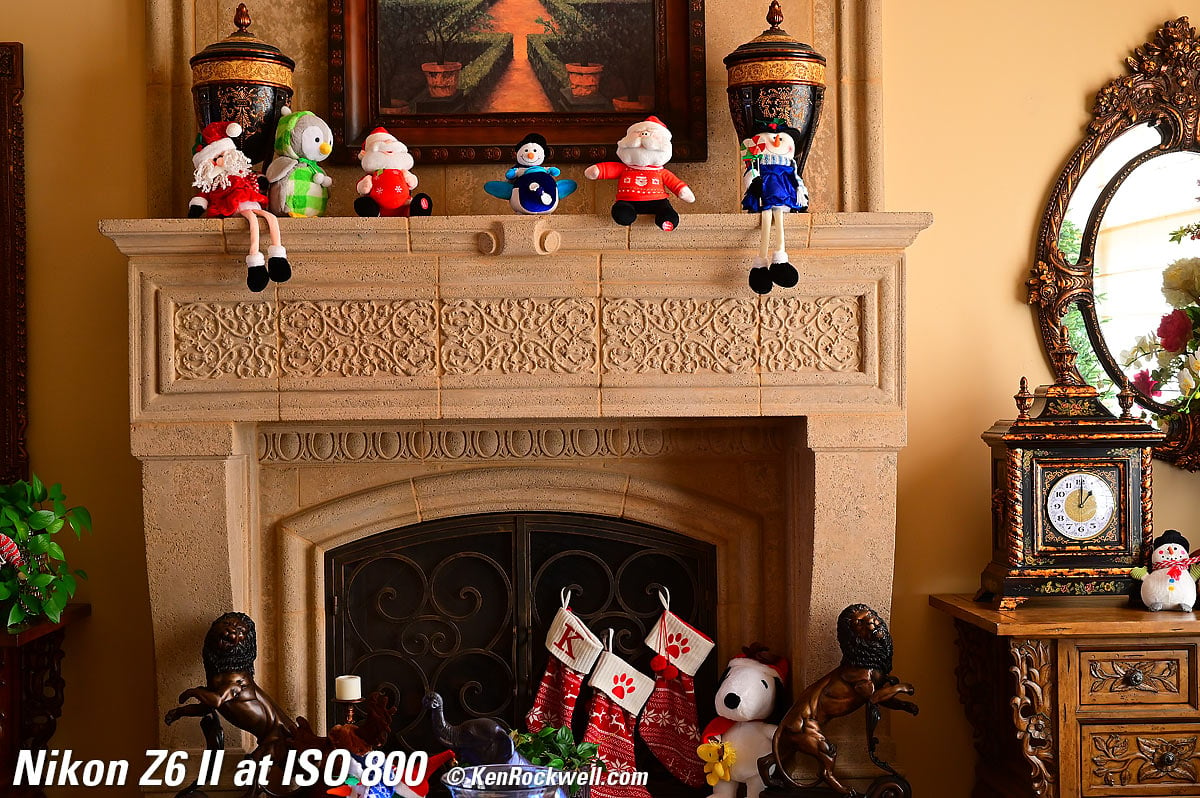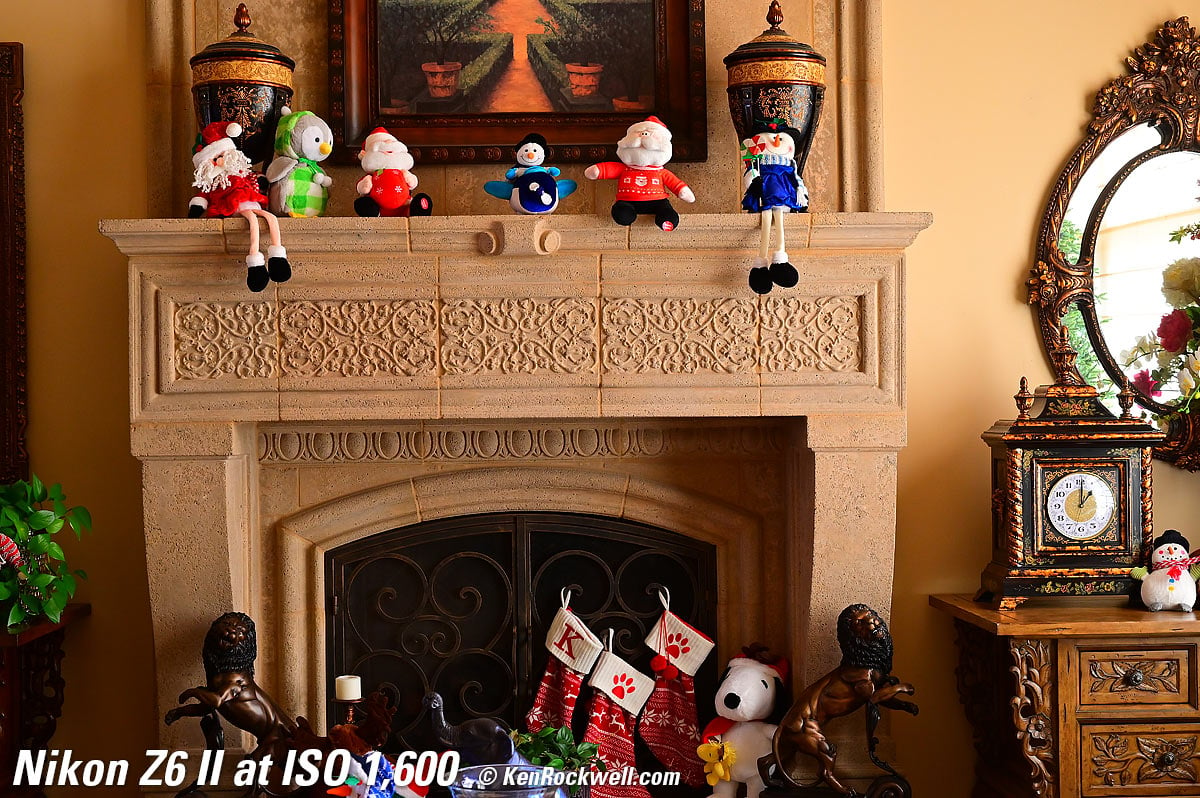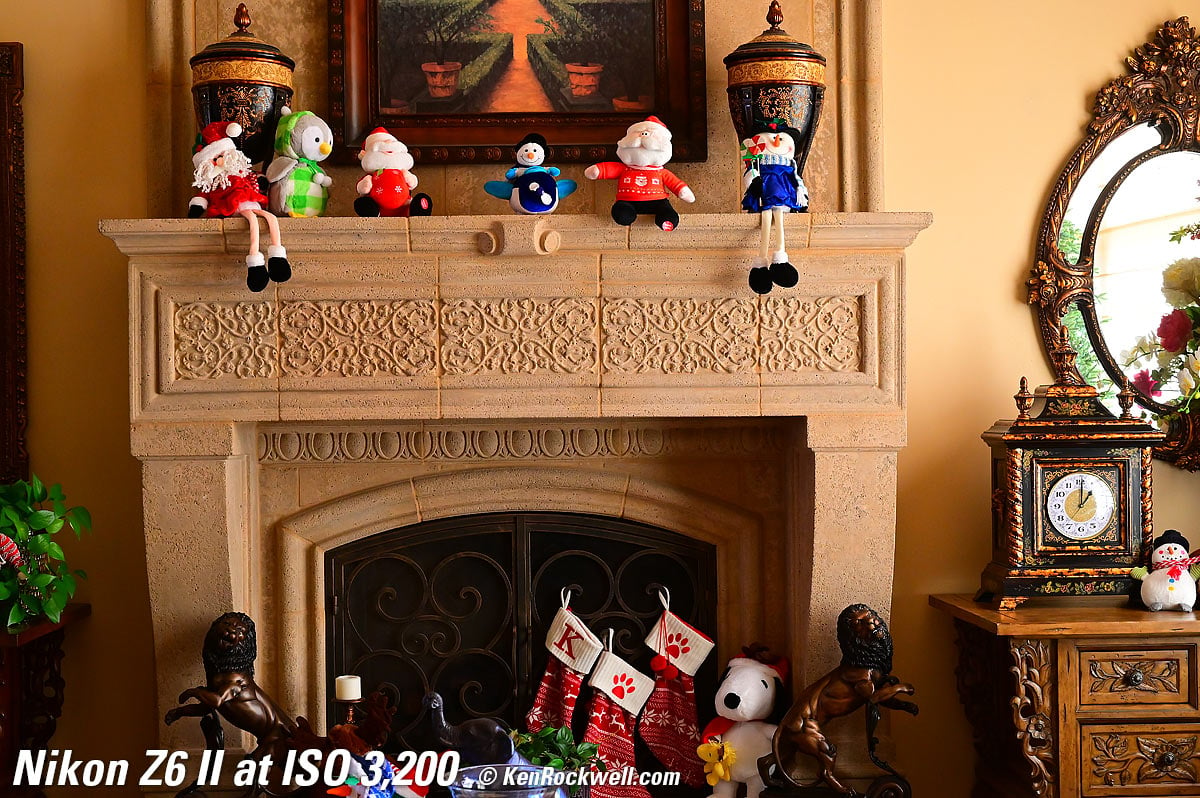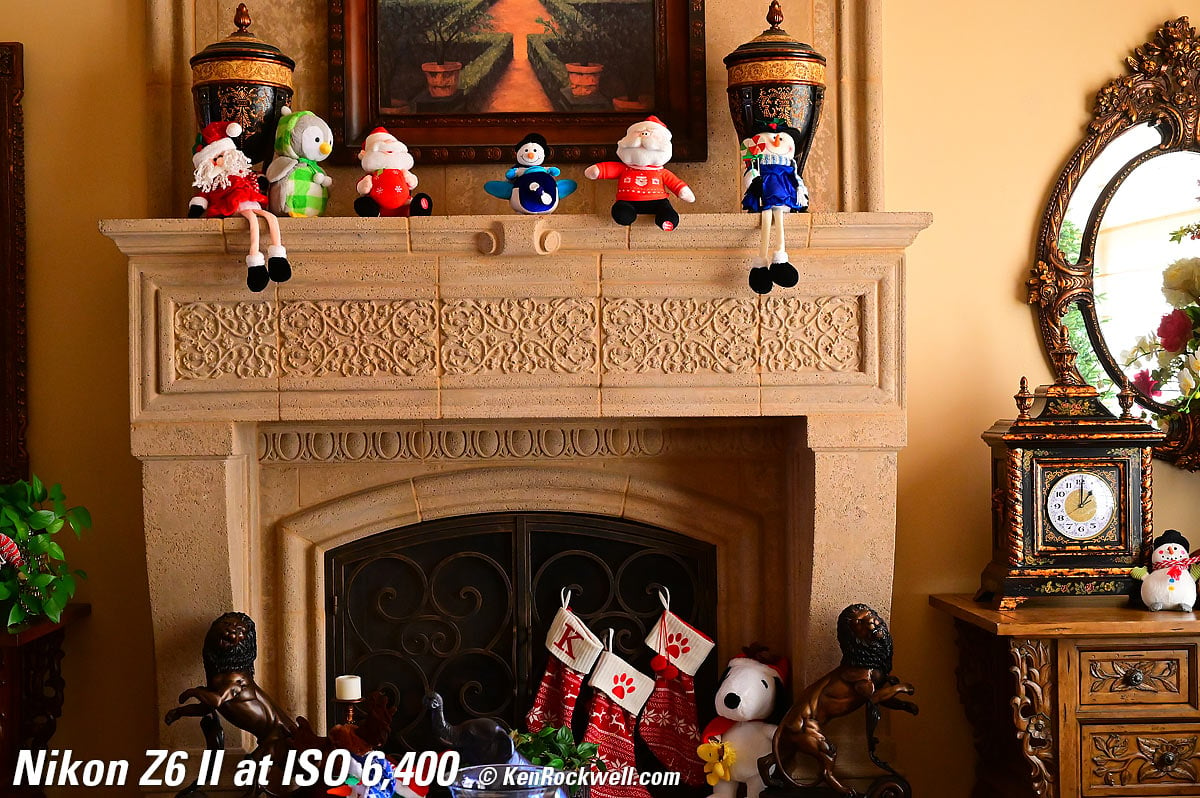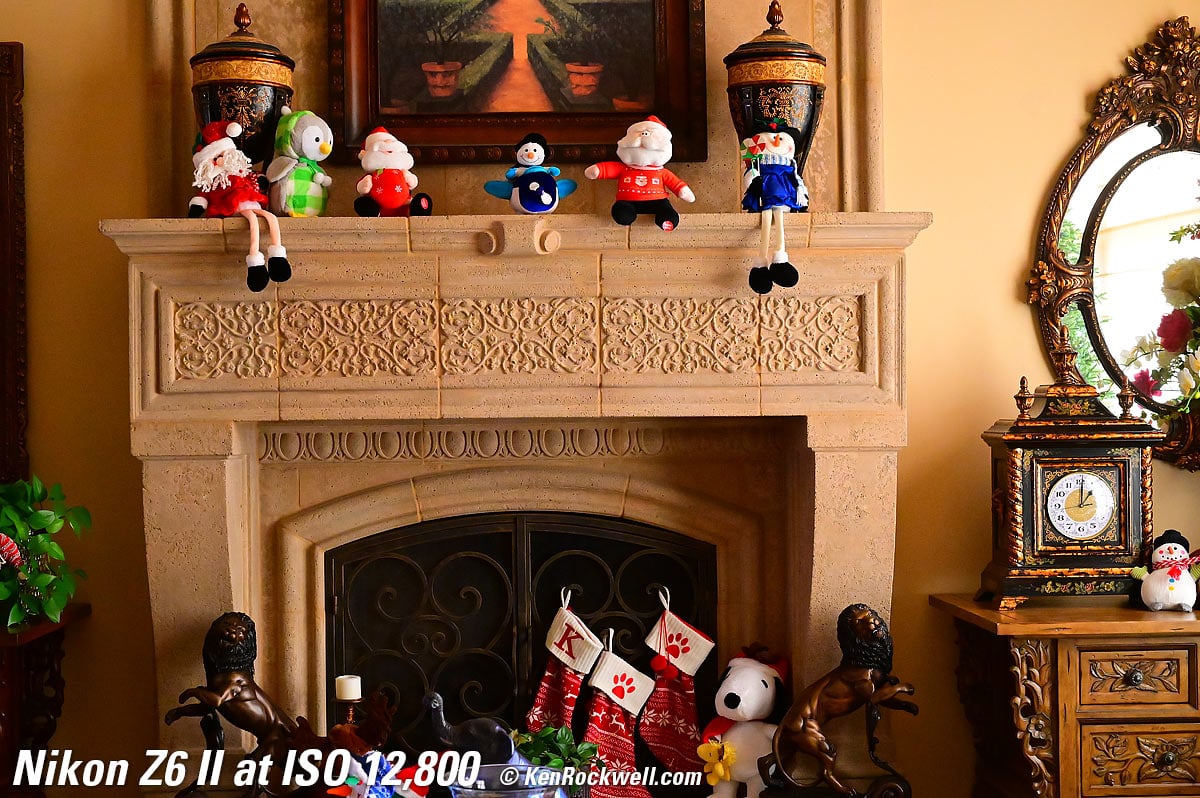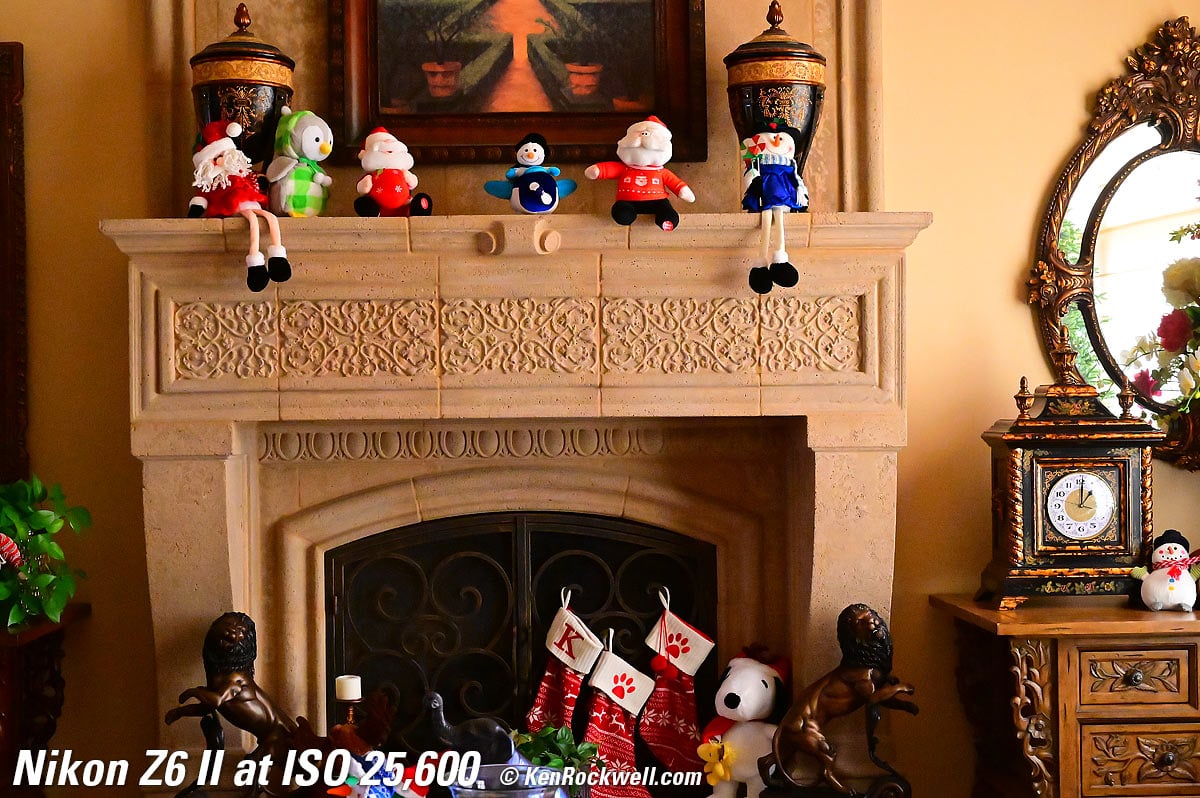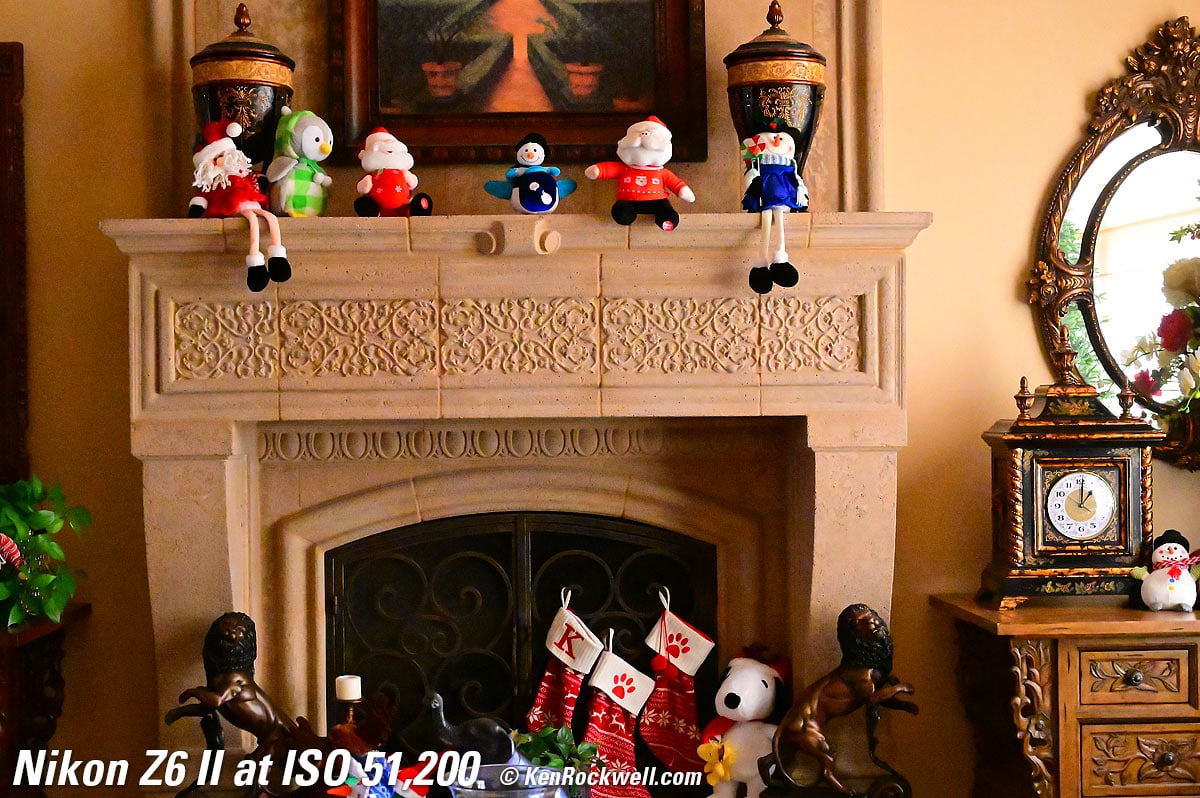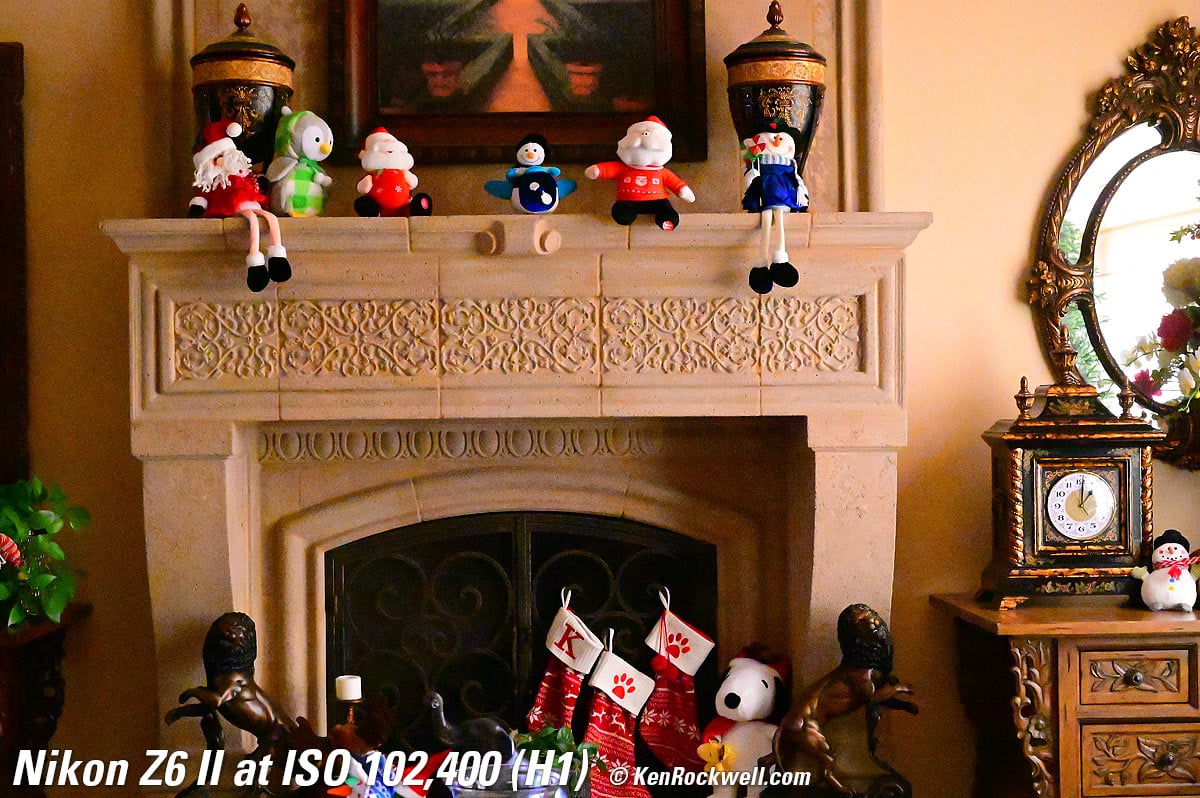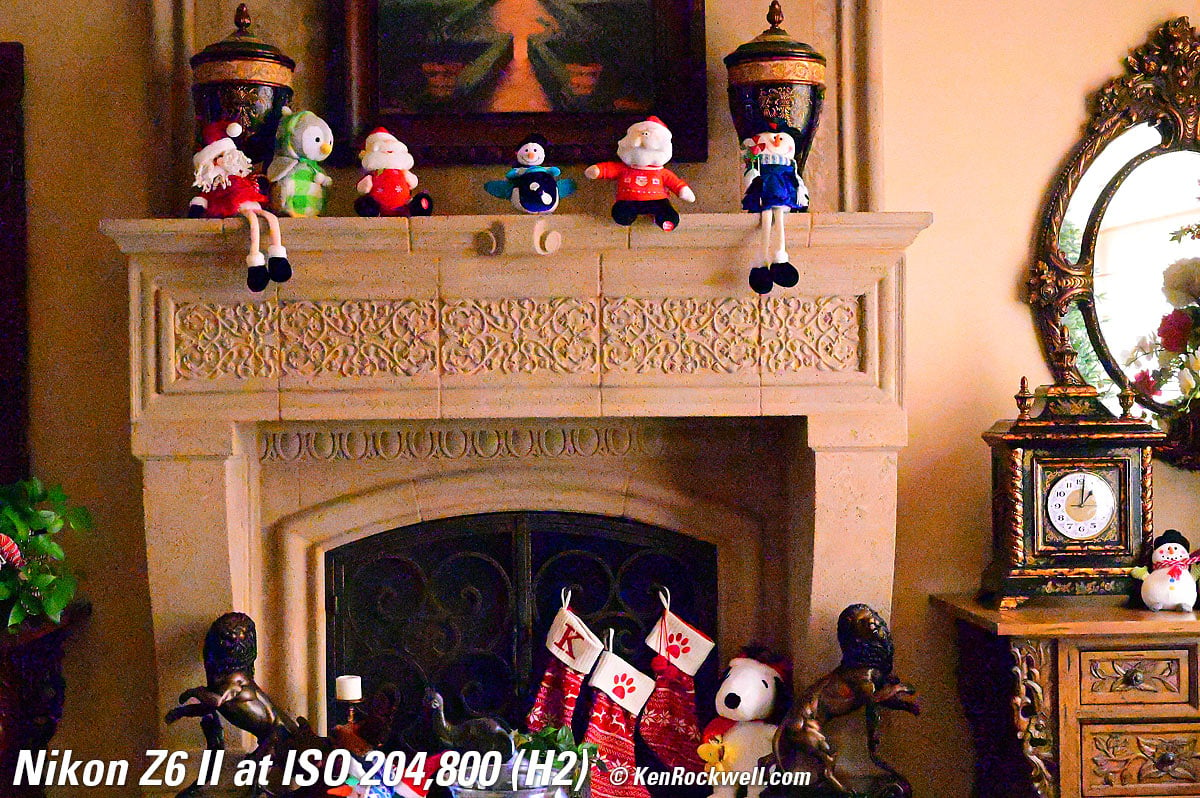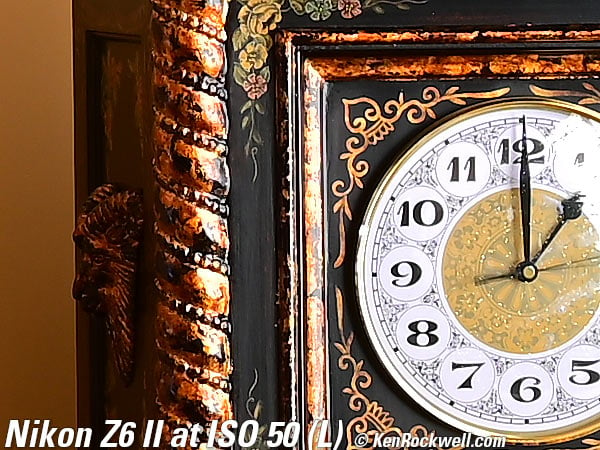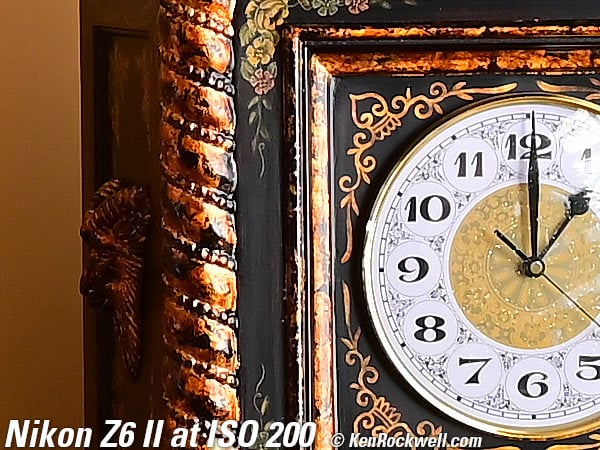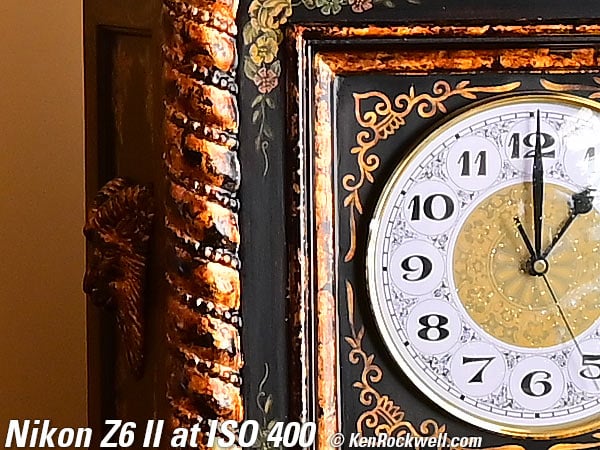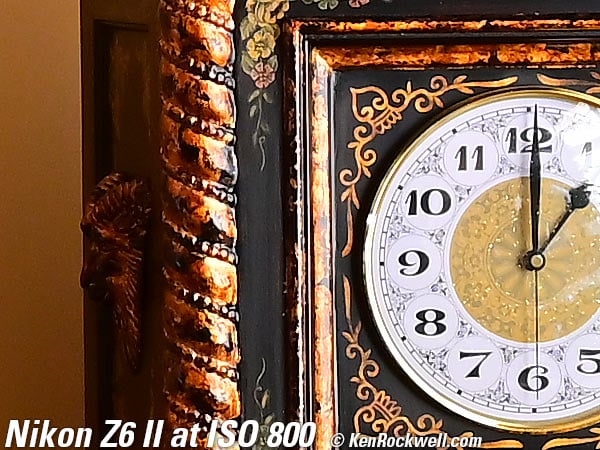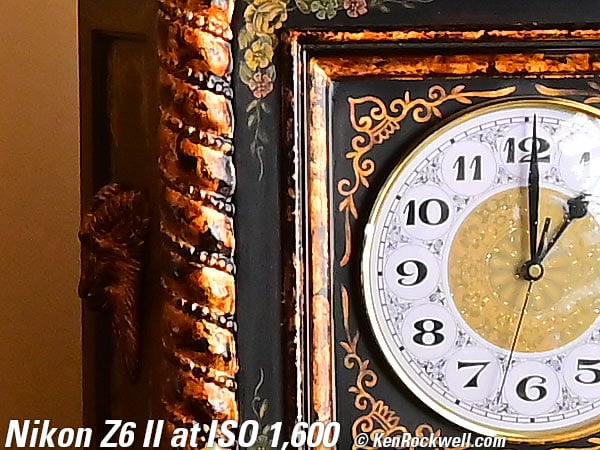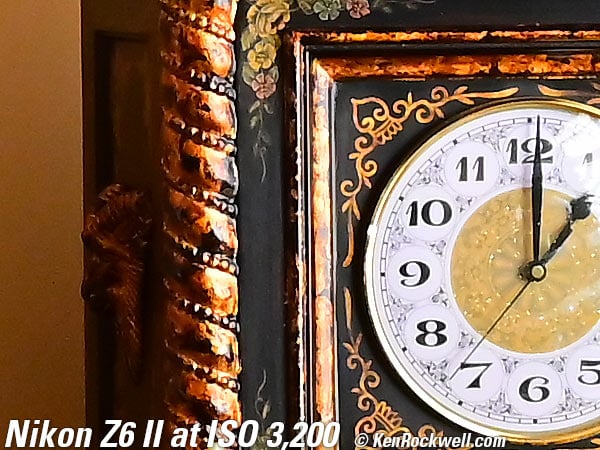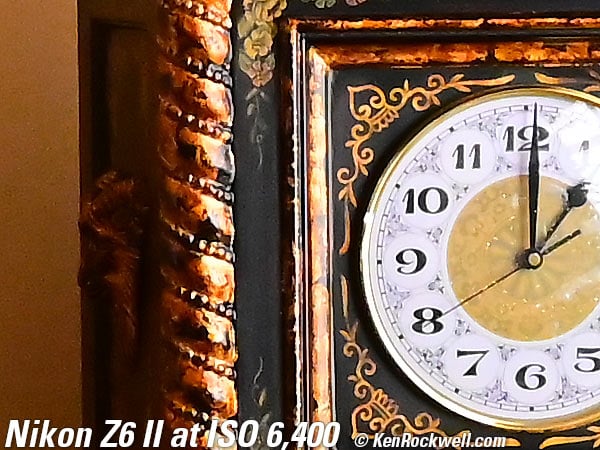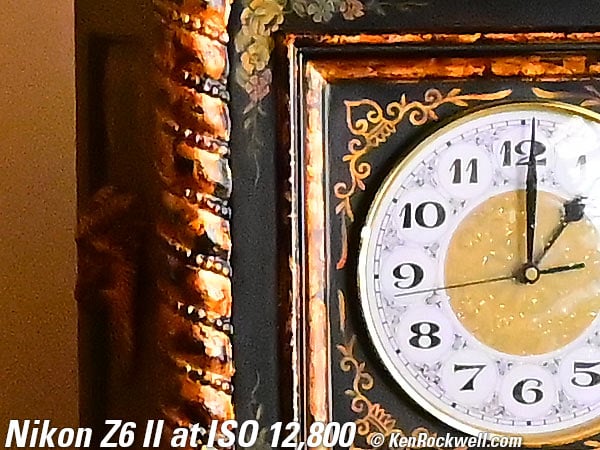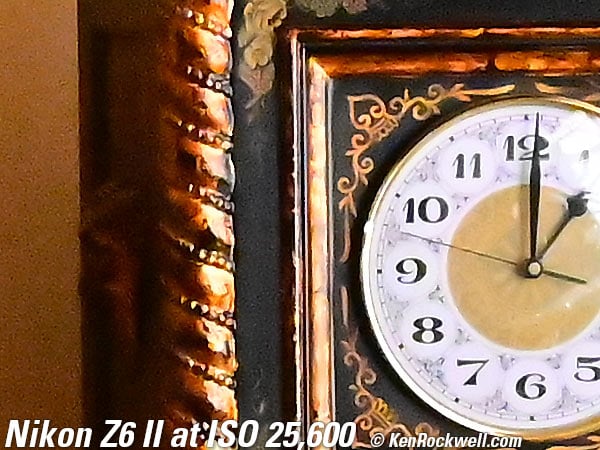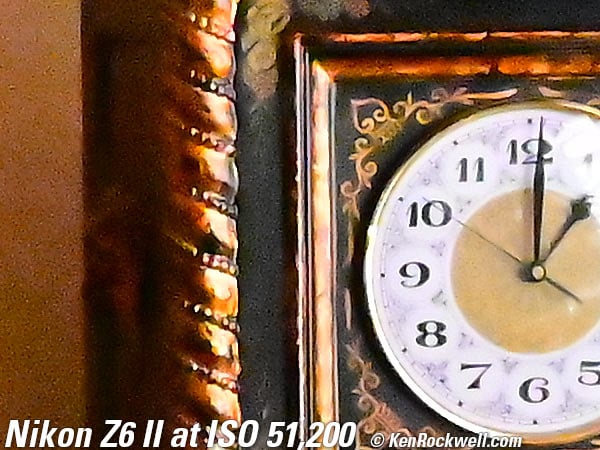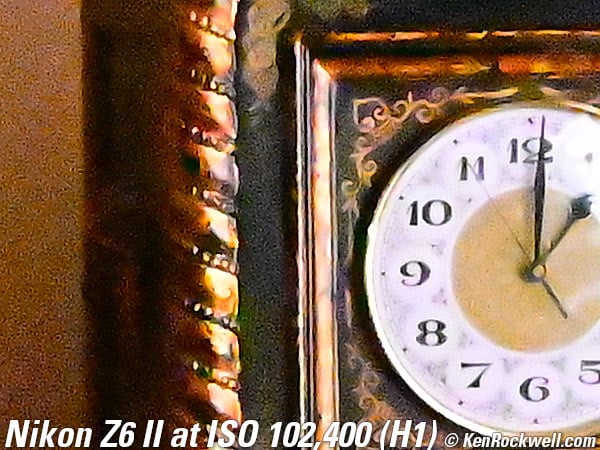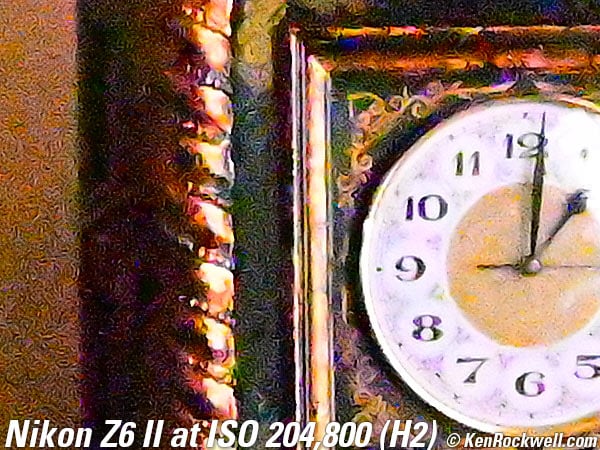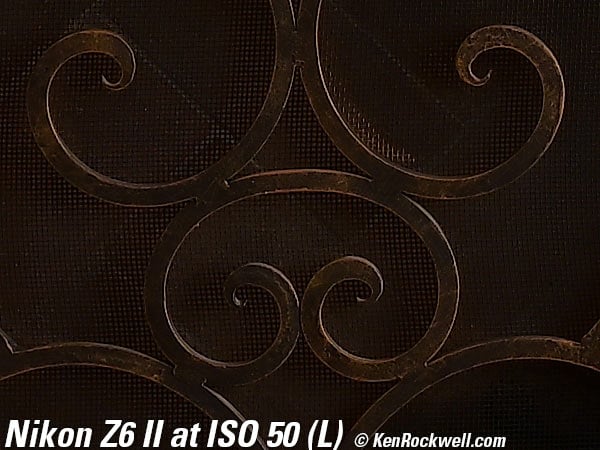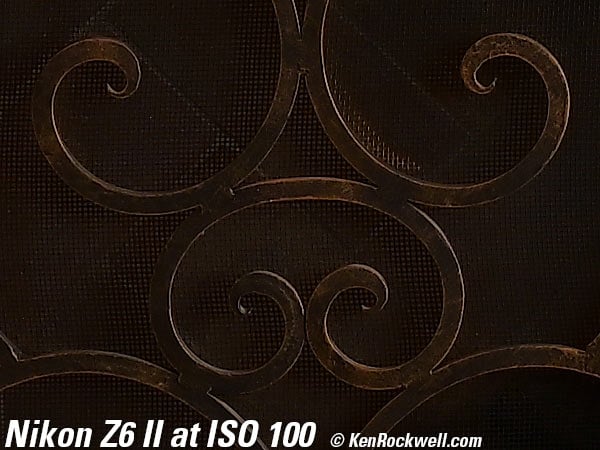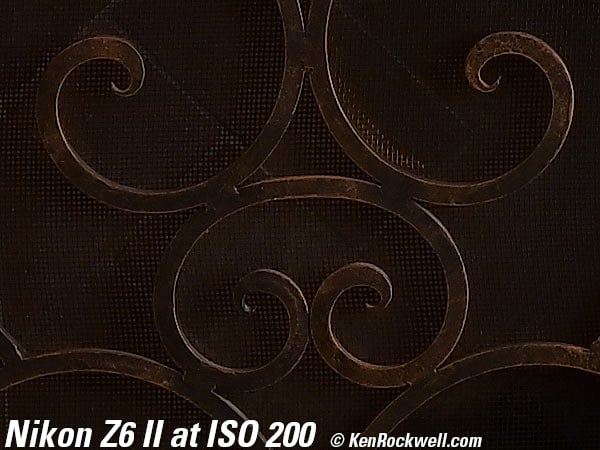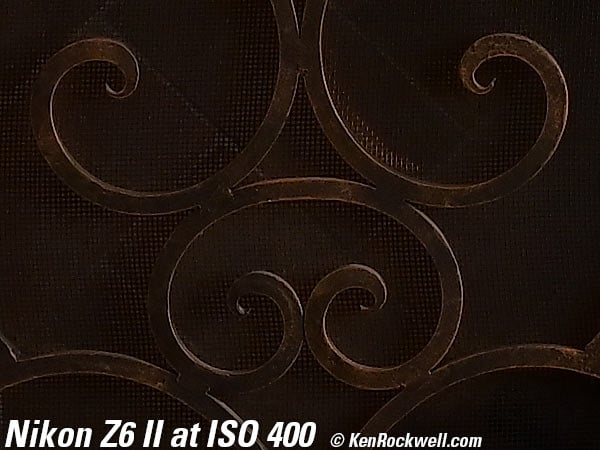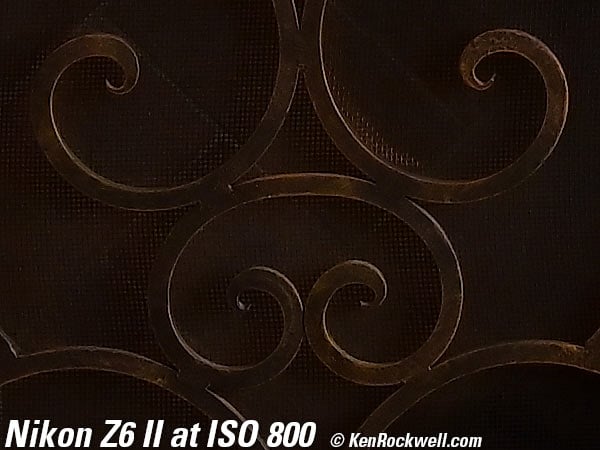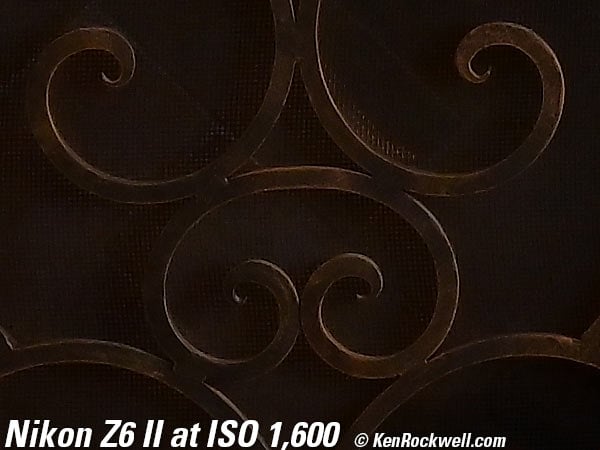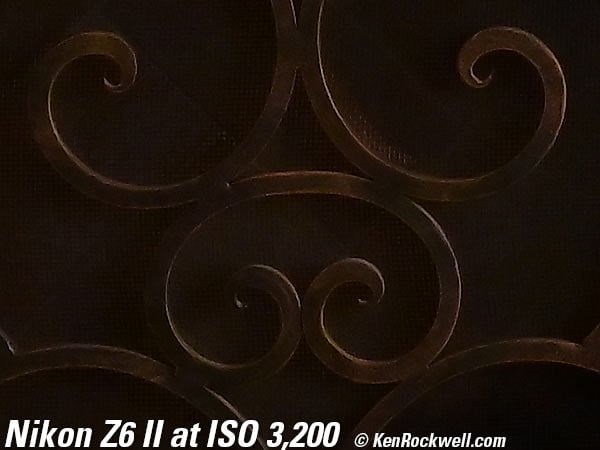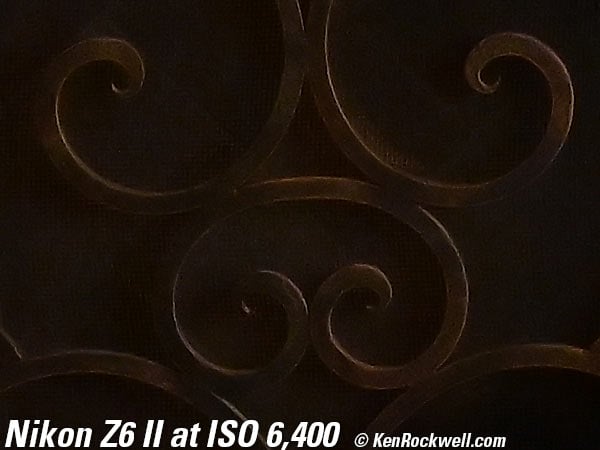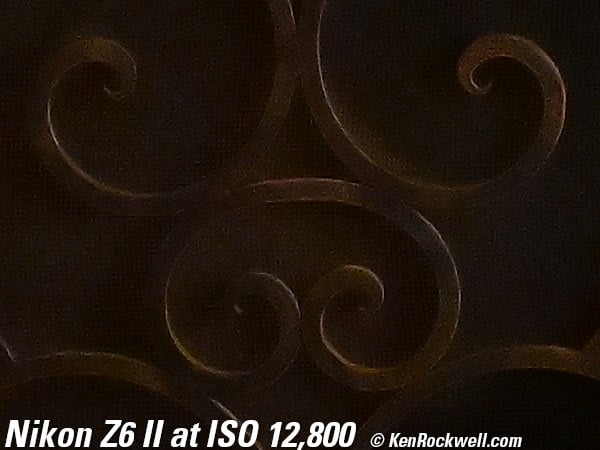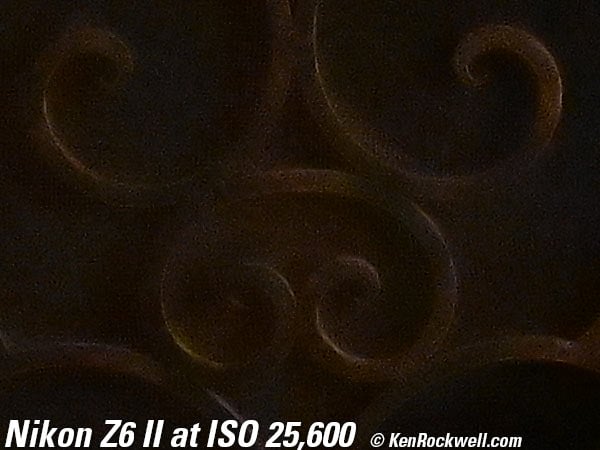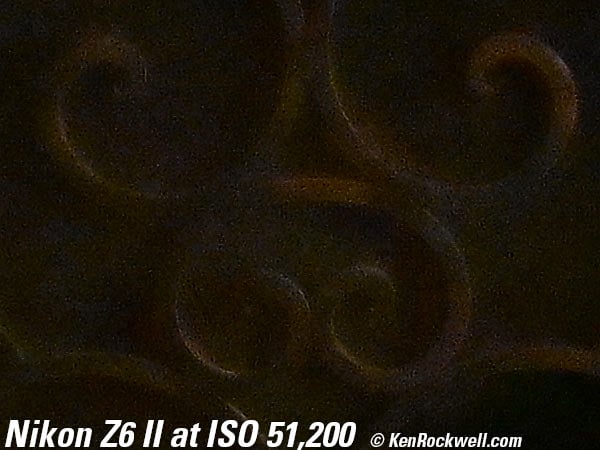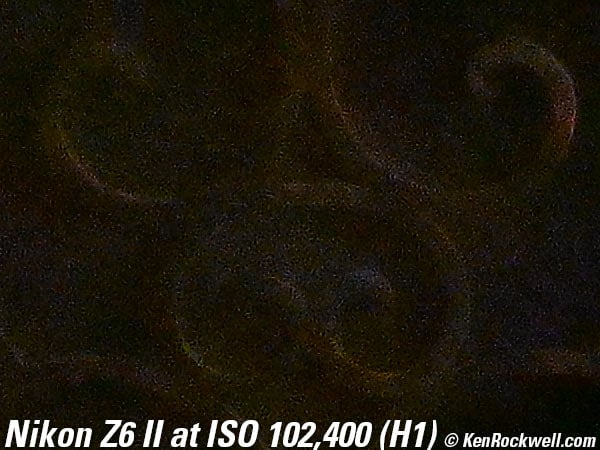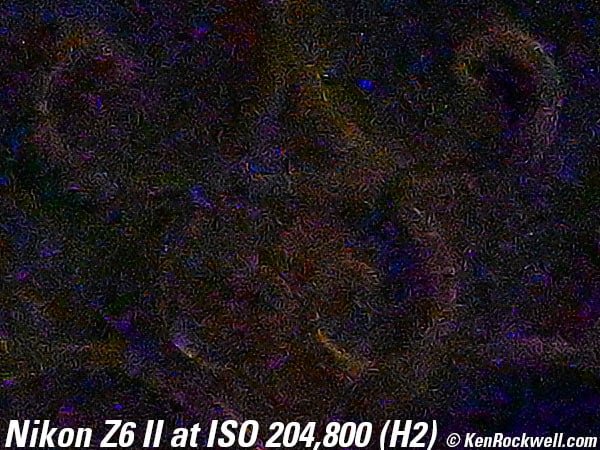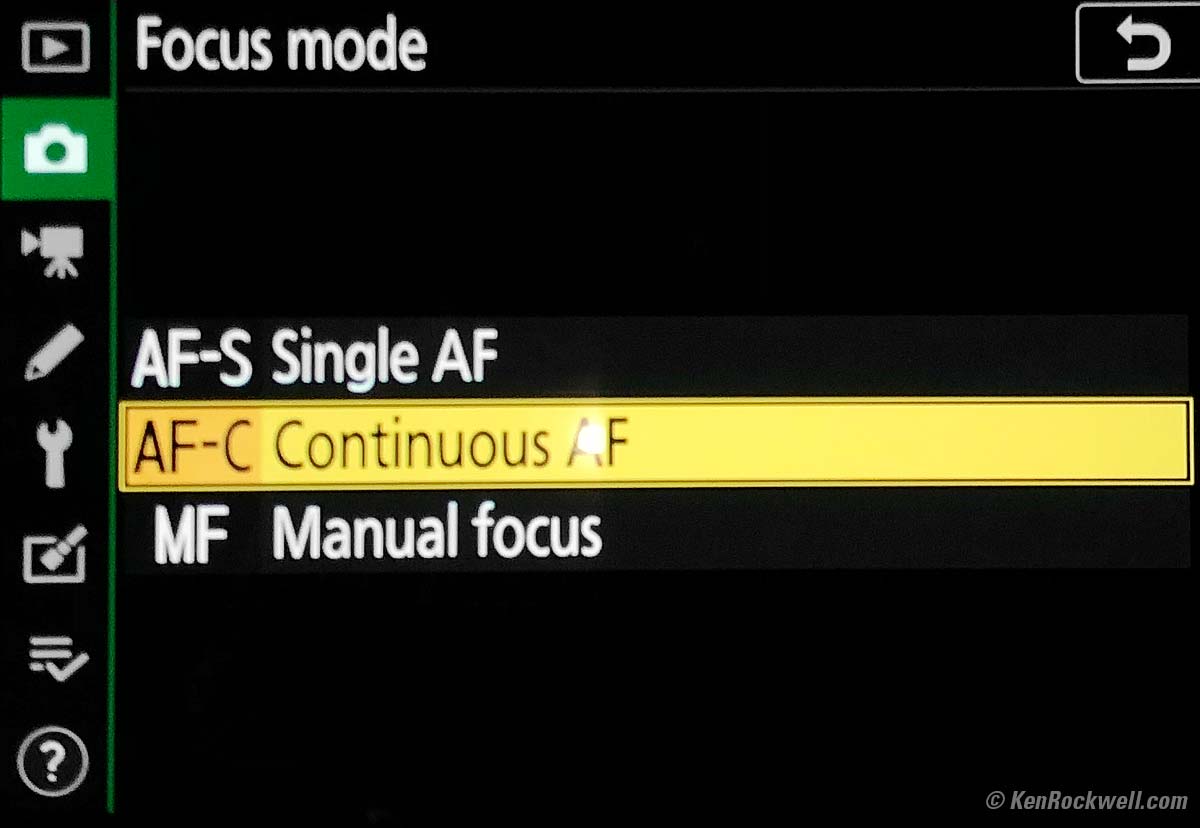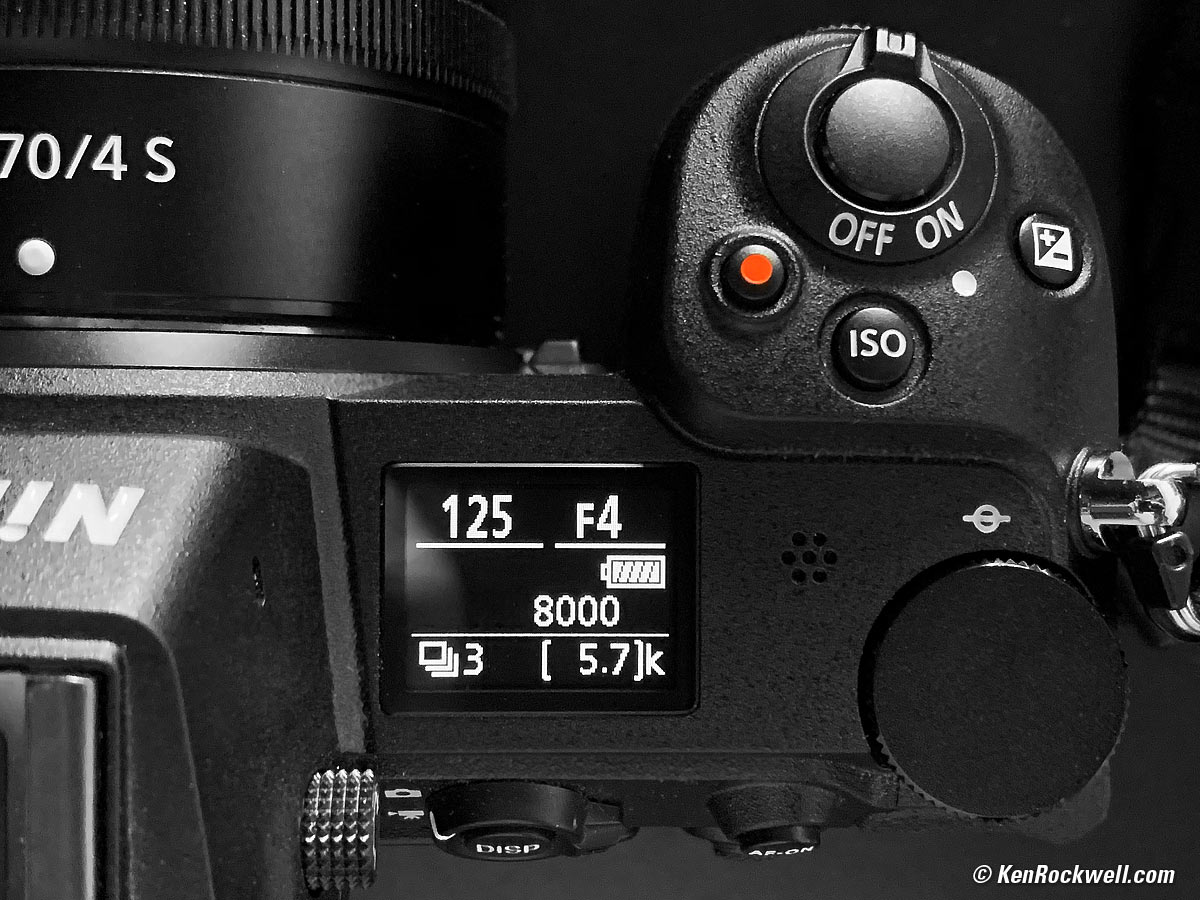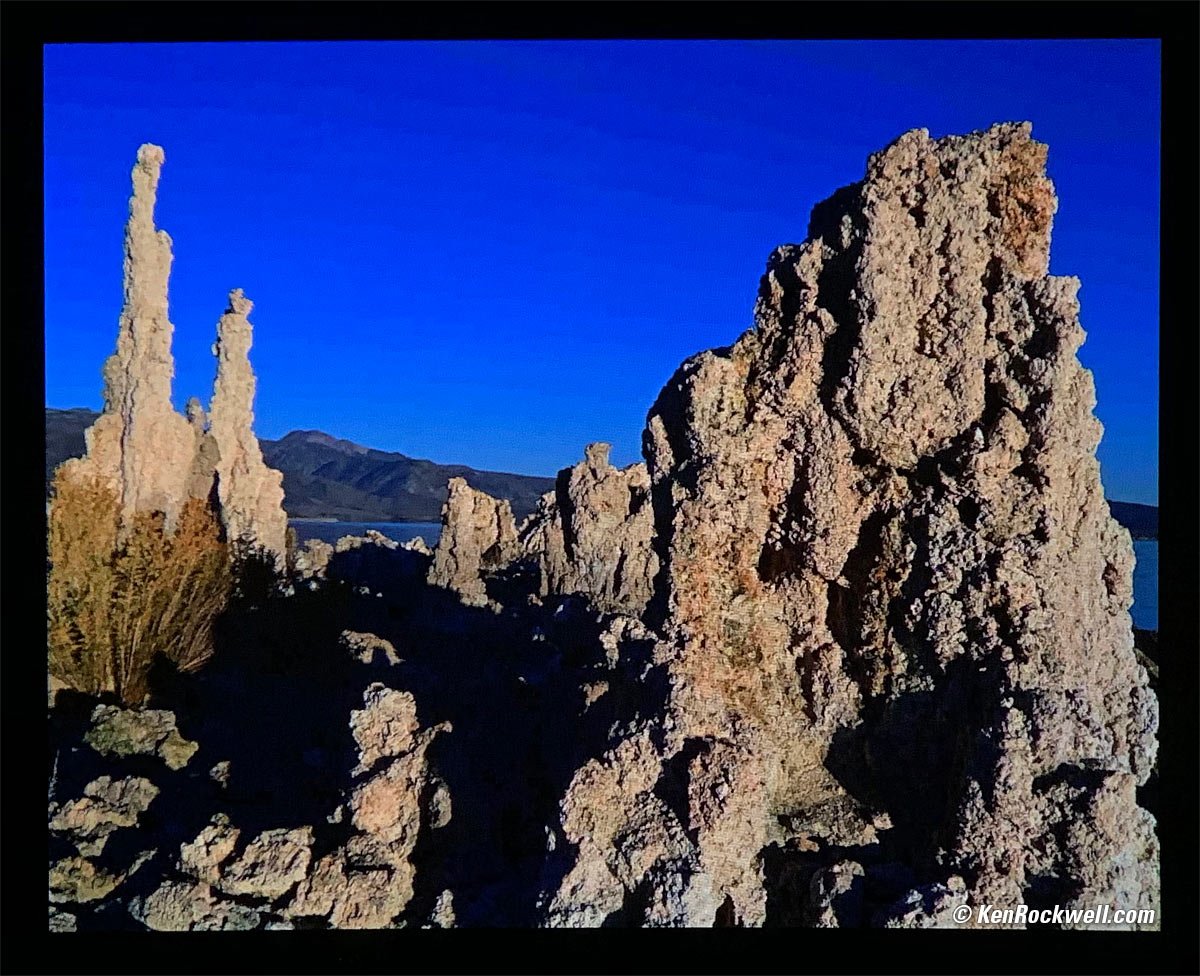Nikon Z6 II
Mirrorless 24MP FX, IBIS, ISO 100~51,200 (50L~204,800H), Silent 14 FPS
Sample Images Intro Lens Compatibility
Adapted Rangefinder Lenses Specifications
Performance Compared User's Guide
Z9 Z8 Z7 II Z6 II Zf Z7 Z6 Z5 Z fc Z50 Z30
Z System Z Lenses All Nikon Lenses Flash
Nikon Z6 II (Z mirrorless lens mount, $1,997, 24.9 oz./705g with battery and one card, has one SD card slot and a second XQD card slot that also works with CFexpress type B cards) and Nikon Z 24-50mm. bigger. I'd get mine at:
Z6 II body-only: $1,697 at Adorama, at Amazon, at B&H and at Crutchfield, or about $1,500 used if you know How to Win at eBay.
Z6 II with discounted 24-70mm f/4: $2,297 at Adorama, at Amazon, at B&H and at Crutchfield.
Z6 II with discounted 24-200mm: $2,397 at B&H. (My favorite combo.)
Z6 II with discounted 24-70mm f/4 and FTZ II adapter: $2,447 and at Adorama and at Amazon.
This 100% all-content, junk-free website's biggest source of support is when you use those or any of these links to my personally approved sources I've used myself for way over 100 combined years when you get anything, regardless of the country in which you live. Nikon does not seal its boxes in any way, so never buy at retail or any other source not on my personally approved list since you'll have no way of knowing if you're missing accessories, getting a defective, damaged, returned, non-USA, store demo or used camera — and all of my personally approved sources allow for 100% cash-back returns for at least 30 days if you don't love your new camera. I've used many of these sources since the 1970s because I can try it in my own hands and return it if I don't love it, and because they ship from secure remote warehouses where no one gets to touch your new camera before you do. Buy only from the approved sources I've used myself for decades for the best prices, service, return policies and selection.
April 2023 Nikon Mirrorless Mirrorless Lenses All Nikon Lenses Nikon Flash All Reviews
Nikon Z6 II Plain-English User's Guide
Nikon vs Canon vs Sony Full Frame Mirrorless Compared
Nikon Z6 II. bigger.
Nikon Z6 II. bigger.
Sample Images
Top Sample Images Intro Lens Compatibility
Adapted Rangefinder Lenses Specifications
Performance Compared User's Guide
These are all shot hand-held as BASIC ★ JPGs; no tripods, NORMAL or FINE JPGs or RAW files were used or needed.
Hot Air Balloon, 4:18 PM, 24 November 2020. Nikon Z6 II in square-crop mode, AF-S 28-300mm VR at 300mm on FTZ adapter, f/5.6 at 1/320 at Auto ISO 180 (LV 12.4), Perfectly Clear. bigger, full-resolution or camera-original © file.
Blue and Green Pool Float, 09 April 2019, 5:27 PM. Nikon Z6 (same sensor as Nikon Z6 II), 1946 5cm (50mm) f/2 NIKKOR-H•C on adapters, f/8 at 1/320 at Auto ISO 100, Perfectly Clear. bigger, full-resolution or camera-original © file.
Not bad for an old weathered pool float shot with an over-70-year-old lens. This lens was Nikon's first lens for its first camera made in occupied Japan a year after World War Two. The Z6 II lets us adapt this and just about any lens to it for great results, complete with Image Stabilization!
Nikon Z6 and 1946 5cm (50mm) f/2 NIKKOR-H•C used to shoot the photo above. The lens is on a Nikon S rangefinder to LEICA M adapter which is on a second LEICA M to Nikon Z adapter. These adapters all come from eBay. bigger.
With a small zoom like the Nikon Z 24-70mm f/4 I can carry my Z6 everywhere to catch what I see as I run errands. Here are six shots made in three hours as I ran around town with my family, hardly a dedicated photo shoot:
Blue Water, 19 March 2019, 2:31 PM. Nikon Z6 (same sensor as Nikon Z6 II), Nikon Z 24-70mm f/4 at 70mm, f/11 at 1/80 at Auto ISO 100, Perfectly Clear. bigger or camera-original © file.
Glass in Dentist's Office, 19 March 2019, 3:49 PM. Nikon Z6 (same sensor as Nikon Z6 II), Nikon Z 24-70mm f/4 at 52mm, f/4 at 1/60 at Auto ISO 900, Perfectly Clear. bigger, full-resolution or camera-original © file.
Liquor, 19 March 2019, 4:49 PM. Nikon Z6 (same sensor as Nikon Z6 II), Nikon Z 24-70mm f/4 at 45mm, f/8 at hand-held at 1/13 at ISO 800, Perfectly Clear. bigger or full-resolution.
Benihana, 19 March 2019, 4:54 PM. Nikon Z6 (same sensor as Nikon Z6 II), Nikon Z 24-70mm f/4 at 24mm, f/4 at 1/25 at Auto ISO 100, Perfectly Clear. bigger or full-resolution.
Las Vegas Roll, 19 March 2019, 5:00 PM. Nikon Z6 (same sensor as Nikon Z6 II), Nikon Z 24-70mm f/4 at 70mm, f/16 at 1/40 at Auto ISO 12,800, Perfectly Clear. bigger, full-resolution or camera-original © file.
Exploding Teppan Grill Volcano Flame, Benihana, 19 March 2019, 5:45 PM. Nikon Z6 (same sensor as Nikon Z6 II), Nikon Z 24-70mm f/4 at 70mm, f/4 at 1/40 at Auto ISO 1,250, Perfectly Clear. bigger or camera-original © file.
Helvetica, 06 April 2019. Nikon Z6 (same sensor as Nikon Z6 II), Nikon Z 24-70mm f/4 at 48mm, f/6.3 at 1/160 at Auto ISO 100, Perfectly Clear. bigger or full-resolution or camera-original © file.
Orange Granite on Green Grass, 06 April 2019. Nikon Z6 (same sensor as Nikon Z6 II), Nikon Z 24-70mm f/4 at 42mm, f/11 at 1/30 at Auto ISO 100, Perfectly Clear. bigger or full-resolution.
A Visit with the LEICAMAN on Lake Constance (Ein Besuch im der LEICAMAN am Bodensee), Lindau, Bavaria, 06 April 2019. Nikon Z6 (same sensor as Nikon Z6 II), Nikon Z 24-70mm f/4 at 70mm, f/11 at 1/30 at Auto ISO 100, Perfectly Clear. bigger or full-resolution.
Introduction
Top Sample Images Intro Lens Compatibility
Adapted Rangefinder Lenses Specifications
Performance Compared User's Guide
|
I buy only from these approved sources. I can't vouch for ads below. |
The Z6 II has a full-frame sensor in a camera that weighs less than a DX D7500, and is built to the same standards as the D850.
It has hybrid phase & contrast autofocus over the entire frame, or over at least 90% of the frame, which is the same as the entire frame since you never put a point of interest on a frame line.
There is a new series of lenses for it, and of course there is an FTZ lens mount adapter so we can use our F-mount lenses. The short flange focal distance means you old-timers from the 1940s and 1950s will be able to mount your original S-mount Nikon rangefinder lenses (as well as LEICA M lenses). We can't do this with DSLRs because their mounts are too deep, but with the short mount of cameras without mirrors it's just a matter of time until someone makes these adapters.
The Z6 II has sensor-shift image stabilization, and it works great, even with ancient 1940s rangefinder lenses!
Z6 II body-only: $1,697 at Adorama, at Amazon, at B&H and at Crutchfield, or about $1,500 used if you know How to Win at eBay.
Z6 II with discounted 24-70mm f/4: $2,297 at Adorama, at Amazon, at B&H and at Crutchfield.
Z6 II with discounted 24-200mm: $2,397 at B&H. (My favorite combo.)
Z6 II with discounted 24-70mm f/4 and FTZ II adapter: $2,447 and at Adorama and at Amazon.
New since the original Z6
 New second SD card slot, along with one XQD slot from the Z7.
New second SD card slot, along with one XQD slot from the Z7.
 XQD slot also works with CFexpress type B cards.
XQD slot also works with CFexpress type B cards.
 Much better autofocus and AF tracking than the old Z6.
Much better autofocus and AF tracking than the old Z6.
 Slightly better High ISO performance than the old Z6 — but you'll only see this in lab tests.
Slightly better High ISO performance than the old Z6 — but you'll only see this in lab tests.
 Timed manual exposures out to 15 minutes (900 seconds) if you enable them at MENU > CUSTOM SETTING MENU (pencil icon> Shooting/display > d6 Extended shutter speeds (M) > ON.
Timed manual exposures out to 15 minutes (900 seconds) if you enable them at MENU > CUSTOM SETTING MENU (pencil icon> Shooting/display > d6 Extended shutter speeds (M) > ON.
 New as of firmware 1.3 are a voice note option like the D5 or EOS R5.
New as of firmware 1.3 are a voice note option like the D5 or EOS R5.
 Two image processors, up from one in the Z6.
Two image processors, up from one in the Z6.
 Autofocus now rated to work in light about two stops darker than the old Z6.
Autofocus now rated to work in light about two stops darker than the old Z6.
 Light meter now rated to work in light about two stops darker than the old Z6.
Light meter now rated to work in light about two stops darker than the old Z6.
 New EN-EL15c battery has slightly more capacity than the older EN-EL15, EN-EL15a and EN-EL15b batteries.
New EN-EL15c battery has slightly more capacity than the older EN-EL15, EN-EL15a and EN-EL15b batteries.
 New optional MB-N11 vertical battery grip.
New optional MB-N11 vertical battery grip.
 4K 60p "planned for" February 2021 (iPhones have done this since the iPhone X of 2017).
4K 60p "planned for" February 2021 (iPhones have done this since the iPhone X of 2017).
 Reversible focus ring directions.
Reversible focus ring directions.
 Cthulhu, Pig Latin, Olde English, Mime and Klingon added to Language Options.
Cthulhu, Pig Latin, Olde English, Mime and Klingon added to Language Options.
 1.3 oz. (38g) heavier than the old Z6.
1.3 oz. (38g) heavier than the old Z6.
 Now includes the MH-25A external battery charger not included with the original Z6. (I never use it; I charge in-camera via USB.)
Now includes the MH-25A external battery charger not included with the original Z6. (I never use it; I charge in-camera via USB.)
 Now has twenty numbered "Non-CPU Lens Data" memories for manual-focus lenses.
Now has twenty numbered "Non-CPU Lens Data" memories for manual-focus lenses.
 Offshored to Thailand, no longer made domestically in Japan as was the original Z6.
Offshored to Thailand, no longer made domestically in Japan as was the original Z6.
Good
 Full Frame Autofocus. You have sensors all over the entire frame!
Full Frame Autofocus. You have sensors all over the entire frame!
 In-camera sensor-shift image-stabilization rated for 5 stops improvement.
In-camera sensor-shift image-stabilization rated for 5 stops improvement.
 Timed manual exposures out to 15 minutes (900 seconds) if you enable them at MENU > CUSTOM SETTING MENU (pencil icon> Shooting/display > d6 Extended shutter speeds (M) > ON.
Timed manual exposures out to 15 minutes (900 seconds) if you enable them at MENU > CUSTOM SETTING MENU (pencil icon> Shooting/display > d6 Extended shutter speeds (M) > ON.
 Optional setting for completely silent operation.
Optional setting for completely silent operation.
 New as of firmware 1.3 are a voice note option like the D5 or EOS R5.
New as of firmware 1.3 are a voice note option like the D5 or EOS R5.
 Three user presets on the top dial: U1, U2 and U3.
Three user presets on the top dial: U1, U2 and U3.
 Optional square 1:1 and 16:9 crops as-shot. I usually shoot in 1:1 since the native 3:2 is usually to long and skinny for me, and with square images I never have to turn the camera to shoot verticals.
Optional square 1:1 and 16:9 crops as-shot. I usually shoot in 1:1 since the native 3:2 is usually to long and skinny for me, and with square images I never have to turn the camera to shoot verticals.
 Ultra-short 16mm Flange Focal Distance (FFD) allows all other brands of DSLR, SLR and rangefinder lenses to be adapted to it.
Ultra-short 16mm Flange Focal Distance (FFD) allows all other brands of DSLR, SLR and rangefinder lenses to be adapted to it.
 HDR.
HDR.
 Flicker shoot-through.
Flicker shoot-through.
 Superior Nikon image quality for colors and dynamic range. No longer do we have to settle for inferior Sony or Fuji color rendition just to get mirrorless!
Superior Nikon image quality for colors and dynamic range. No longer do we have to settle for inferior Sony or Fuji color rendition just to get mirrorless!
 Crud-resistant fluorine-coated finder eyepiece.
Crud-resistant fluorine-coated finder eyepiece.
 Aspherical eyepiece elements.
Aspherical eyepiece elements.
 Wi-Fi and Bluetooth.
Wi-Fi and Bluetooth.
 Multiple exposures.
Multiple exposures.
 Flash system fully compatible with Nikon's existing DSLR flashes, with both optical and radio remote control.
Flash system fully compatible with Nikon's existing DSLR flashes, with both optical and radio remote control.
Bad
 Offshored to Thailand, no longer made domestically in Japan like the original Z6.
Offshored to Thailand, no longer made domestically in Japan like the original Z6.
 Still essentially the same as 2018's Z6, which makes this camera already obsolete and way behind Canon's brand-new and far superior EOS R6. This camera's lack of innovation shows me it's time to jump ship from Nikon and upgrade to Canon rather than throw more money at the number-three camera brand.
Still essentially the same as 2018's Z6, which makes this camera already obsolete and way behind Canon's brand-new and far superior EOS R6. This camera's lack of innovation shows me it's time to jump ship from Nikon and upgrade to Canon rather than throw more money at the number-three camera brand.
 New second card slot only works with expensive XQD or CFexpress type B cards. The least expensive version of any of these costs 5% to 10% the price of the Z6 II body! The second slot should have been another SD slot.
New second card slot only works with expensive XQD or CFexpress type B cards. The least expensive version of any of these costs 5% to 10% the price of the Z6 II body! The second slot should have been another SD slot.
 There's an 82 kB junk file called "NC_FLLST.DAT" in each image folder.
There's an 82 kB junk file called "NC_FLLST.DAT" in each image folder.
 The FTZ adapter autofocuses only with Nikon's newest lenses with a built-in AF motor (AF-S and AF-P). It does not autofocus with any other lenses. The FTZ is a dud for those of us with a large collection of Nikon lenses because it only works (autofocuses or indexes properly) with about half of them. Nikon likes to forget to mention that all traditional AF and AF-D (screw-type) lenses will not autofocus. The FTZ works very poorly with manual-focus F, AI , AI'd and AI-s lenses, having no diaphragm control meaning you have to open and close the diaphragm manually for precise focus before and after each shot, has no exposure or EXIF data so you have no in-finder indication of aperture and have no EXIF aperture data, and there is no Matrix metering, Program or Shutter-priority automation with manual-focus lenses — which offer all these functions and more if used on 1984's Nikon FA! Worse, the Z6 II's automatic viewfinder brightness varies all over the place as you change the aperture on a manual lens. F, AI , AI'd, AI-s, AF and AF-D lenses, many of which Nikon still sells new today, work much better on any FX DSLR like a D750. Poo!
The FTZ adapter autofocuses only with Nikon's newest lenses with a built-in AF motor (AF-S and AF-P). It does not autofocus with any other lenses. The FTZ is a dud for those of us with a large collection of Nikon lenses because it only works (autofocuses or indexes properly) with about half of them. Nikon likes to forget to mention that all traditional AF and AF-D (screw-type) lenses will not autofocus. The FTZ works very poorly with manual-focus F, AI , AI'd and AI-s lenses, having no diaphragm control meaning you have to open and close the diaphragm manually for precise focus before and after each shot, has no exposure or EXIF data so you have no in-finder indication of aperture and have no EXIF aperture data, and there is no Matrix metering, Program or Shutter-priority automation with manual-focus lenses — which offer all these functions and more if used on 1984's Nikon FA! Worse, the Z6 II's automatic viewfinder brightness varies all over the place as you change the aperture on a manual lens. F, AI , AI'd, AI-s, AF and AF-D lenses, many of which Nikon still sells new today, work much better on any FX DSLR like a D750. Poo!
 No AF MODE (M, AFC, AFS) switch; you have to assign a button and use dials to set this.
No AF MODE (M, AFC, AFS) switch; you have to assign a button and use dials to set this.
Missing
 No built-in flash.
No built-in flash.
 Finder data doesn't rotate when held vertically.
Finder data doesn't rotate when held vertically.
 The FTZ adapter autofocuses with F-mount lenses with a built-in AF motor (AF-S and AF-P), but does not autofocus with traditional AF and AF-D (screw-type) lenses.
The FTZ adapter autofocuses with F-mount lenses with a built-in AF motor (AF-S and AF-P), but does not autofocus with traditional AF and AF-D (screw-type) lenses.
 Nikon specifies no battery life figure.
Nikon specifies no battery life figure.
 No auto brightness control for the rear LCD; heck, even my iPhone does this. (the finder does have auto brightness control).
No auto brightness control for the rear LCD; heck, even my iPhone does this. (the finder does have auto brightness control).
 No AF-A mode (automatic selection between single AF-S and continuous AF-C modes).
No AF-A mode (automatic selection between single AF-S and continuous AF-C modes).
 No GPS, but you might be able to tag images using your phone over an app.
No GPS, but you might be able to tag images using your phone over an app.
 No 4:3 or 4:5 crops, but does have square 1:1 and 16:9 crops. (Oddly the Z7 II has the 4:5 crop).
No 4:3 or 4:5 crops, but does have square 1:1 and 16:9 crops. (Oddly the Z7 II has the 4:5 crop).
 Unlike the Z7 II, the Z6 II does not include a EH-7P Charging AC Adapter. The Z6 II does include the MH-25A external battery charger, but I always charge via USB and ignore these.
Unlike the Z7 II, the Z6 II does not include a EH-7P Charging AC Adapter. The Z6 II does include the MH-25A external battery charger, but I always charge via USB and ignore these.
 No changes to sensor, shutter, viewfinder, body, or rear LCD.
No changes to sensor, shutter, viewfinder, body, or rear LCD.
Lens Compatibility
Top Sample Images Intro Lens Compatibility
Adapted Rangefinder Lenses Specifications
Performance Compared User's Guide
Z6 II body-only: $1,697 at Adorama, at Amazon, at B&H and at Crutchfield, or about $1,500 used if you know How to Win at eBay.
Z6 II with discounted 24-70mm f/4: $2,297 at Adorama, at Amazon, at B&H and at Crutchfield.
Z6 II with discounted 24-200mm: $2,397 at B&H. (My favorite combo.)
Z6 II with discounted 24-70mm f/4 and FTZ II adapter: $2,447 and at Adorama and at Amazon.
Nikon Z6 II. bigger.
The Z6 II uses a brand-new Nikon Z mount optimized for Nikon's new Z-mount mirrorless S lenses. It has a 55mm inner diameter, larger than the old F mount, and has a flange focal distance of only 16.00mm.
This is the shortest distance between flange and sensor of any pro camera: Sony E is 18.00mm, Fuji X is 17.70mm. Canon RF is 20.00mm, LEICA M is 27.80mm, Contax G is 29.00mm, Nikon's 1950s rangefinder S-mount is 34.85mm. Canon EF is 44.00mm and Nikon F is 46.5mm, so there is always enough room for someone to machine an adapter ring to go between anything and this new Nikon Z mount.
DX Z Lenses
Ideally only use FX lenses on this FX camera.
The DX 16-50 and DX 50-250mm are superb lenses, and the Z6 II automatically crops its sensor to DX, but by doing this you're throwing away more than half your sensor area and getting less resolution than by shooting these lenses on a Z50.
FTZ Adapter
I have an entire page on what works and doesn't work with Nikon's FTZ adapter, which lets Nikon's F-Mount lenses mount on a Z camera.
In short, all the newest AF-I, AF-S and AF-P lenses work fine with Nikon's FTZ adapter, while there is no autofocus with any other lenses, and especially no autofocus with older AF and AF‑D lenses, many of which Nikon still sells new today.
Manual-Focus F, AI converted, AI and AI‑s don't work very well, with no communication or control of aperture. Manual-focus lenses work much better on any FX DSLR than on the FTZ.
See all the details at Nikon FTZ Compatibility & Review.
Fringer Canon EF-to-Nikon Z Adapter
Adapts Canon EF lenses with often better results on my Nikon Z cameras than Nikon's own lenses give on this crappy FTZ adapter! It also works with other brands of lenses in Canon EF mount, adapting them to Nikon Z.
Adapted Rangefinder Lenses
Nikon Z7 with W-NIKKOR•C 3.5cm f/1.8 (1956~1964). bigger.
You don't need and can't use the FTZ Adapter with rangefinder lenses. These lenses have to get closer to the sensor, and are the original mirrorless lenses. This is good, because we can get basic adapters cheap direct from China over eBay for just about any kind of lens.
In fact, we now can use even Nikon's original 1940s-1960s rangefinder lenses on the Z6 II!
LEICA's lenses for the LEICA M3 with goggles work great, too!
See Use with Adapted Rangefinder Lenses for more.
Palms and Storm, 6:21 PM, 29 November 2018. 2018 Nikon Z7 with 1956 W-NIKKOR•C 3.5cm f/1.8 (see Adapting Rangefinder Lenses to Nikon Mirrorless), f/4 at 10 seconds at ISO 64, shown exactly as shot. bigger or camera-original © file. The palm tree is blowing all over in the wind; don't expect it to be museum-sharp.
Specifications
Top Sample Images Intro Lens Compatibility
Adapted Rangefinder Lenses Specifications
Performance Compared User's Guide
Z6 II body-only: $1,697 at Adorama, at Amazon, at B&H and at Crutchfield, or about $1,500 used if you know How to Win at eBay.
Z6 II with discounted 24-70mm f/4: $2,297 at Adorama, at Amazon, at B&H and at Crutchfield.
Z6 II with discounted 24-200mm: $2,397 at B&H. (My favorite combo.)
Z6 II with discounted 24-70mm f/4 and FTZ II adapter: $2,447 and at Adorama and at Amazon.
Autofocus
273 AF points.
Phase and contrast detection.
90% linear frame coverage.
Range: LV -4.5 ~ +19; LV -6 ~ +19 with "low light AF" (both with f/2 lens).
Distance-Axis AF Modes
AF-S (single and lock), AF-S (continuous tracking) with predictive tracking.
"Full-time" AF-F in movie mode only.
Manual focus.
Electronic rangefinder.
AF-Area Selection Modes (X & Y axes)
Auto area selection.
Pinpoint (still photo mode only).
Single-point.
Dynamic area AF (still photo mode only).
Wide-area AF (S or L).
Image Sensor specifications top
Nikon Z6 II. bigger.
23.9 × 35.9 mm backside-illuminated CMOS with phase-detection AF pixels.
24 MP.
Ultrasonic cleaner.
Image Dust Off reference data (requires Capture NX-D).
ISO specifications top
ISO 100 ~ 51,200.
Pullable to ISO 50 and pushable to ISO 204,800.
Image Stabilization specifications top
5-axis in-camera sensor-shift.
Works great with VR lenses, too.
Additional electronic stabilization for video.
Rated 5 stops with Nikon Z mount lenses, 3-stops with non-VR F-mount lenses.
With F-mount VR lenses the camera corrects roll while the lens corrects pitch and yaw.
With F-mount non-VR lenses the camera corrects roll, pitch and yaw.
Auto ISO specifications top
Programmable for high and low limits from ISO 100 to ISO 204,800.
Still Image Sizes specifications top
Full-Frame
6,048 × 4,024 pixels native (Large, 24.34 MP)
4,528 × 3,016 (Medium, 13.7 MP)
3,024 × 2,016 (Small, 6.1 MP)
Cropped
4:5 (24 × 30mm)
NO 4:5 crop; you need the Z7 II for that.
Square 1:1 (24 × 24mm)
4,016 × 4,016 (Large, 16.1 MP)
3,008 × 3,008 (Medium, 9.0 MP)
2,000 × 2,000 (Small, 4.0 MP)
16:9 (20 × 36mm)
6,048 × 3,400 (Large, 20.6 MP)
4,528 × 2,544 (Medium, 11.5 MP)
3,024 × 1,696 (Small, 5.1 MP)
DX (16 × 24mm)
3,936 × 2,624 (Large, 10.3 MP)
2,944 × 1,968 (Medium, 5.8 MP)
1,968 × 1312 (Small, 2.6 MP)
Stills grabbed while rolling in 4K
3,840 × 2,160
Stills grabbed while rolling video in any other size
1,920 × 1,080
Frame Rates (Still images) specifications top
14 FPS, continuous high "extended." (only 10 FPS in 14-bit raw.) In this "extended" mode it can't track exposure between frames and instead shoots every frame in the sequence at the same locked exposure. I'm unsure if autofocus tracks at this highest rate.
5.5 FPS, Continuous High, with tracking exposure for each frame.
1~5 FPS (adjustable) Continuous Low.
Still Formats specifications top
TIFF, JPG and/or raw.
JPG saved as LARGE, MEDIUM or SMALL resolution in FINE, NORMAL or BASIC compression.
Raw saved as 12- or 14-bit uncompressed, lossy or losslessly compressed at full LARGE resolution.
Raw also may be saved at MEDIUM or SMALL resolutions, but at only 12-bit lossless compressed.
sRGB and Adobe RGB.
Picture Controls specifications top
Auto, Standard, Neutral, Vivid, Monochrome, Portrait, Landscape and Flat.
Gimmick Picture Controls: Dream, Morning, Pop, Sunday, Somber, Dramatic, Silence, Bleached, Melancholic, Pure, Denim, Toy, Sepia, Blue, Red, Pink, Charcoal, Graphite, Binary and Carbon.
Of course these each can be adjusted and saved, and apply to both still images and video.
Video specifications top
Video Frame Sizes and Rates
3,840 × 2,160 (4K UHD 10-bit); 29.97p (progressive), 25p, 23.976p.
1,920 × 1,080; 119.88p, 100p, 59.94p, 50p, 29.97p, 25p, 23.976p.
1,920 × 1,080 (slow-mo); 29.97p ×4, 25p ×4, 23.976p ×5.
Different compression ratios (quality settings) selectable at all sizes except 3,840 × 2,160, 1,920 × 1,080 119.88p/100p, and 1,920 × 1,080 slow-mo, where quality is fixed at high.
Video File Formats & Coding
MOV and MP4.
H.264/MPEG-4 Advanced Video Coding.
AAC and LPCM audio coding.
Video Features
Uses the same Picture Controls as still images.
Active D-Lighting, electronic vibration reduction, and focus peaking can be used with 4K UHD and 1,080 movie recording.
The N-Log color profile can also be used with 10-bit HDMI output. The N-Log setting utilizes extensive color depth and twelve-stop, 1,300% dynamic range to record a wealth of tone information from highlights and shadows for more effective color grading.
Timecode.
Time-lapse.
Electronic vibration reduction.
29:59 (a half hour) maximum take length.
Audio specifications top
Recorded only along with video.
Stereo microphones built in.
Mic-in jack with plug-in power overrides built-in mic.
Headphone jack.
Linear PCM or AAC coding.
Metering Modes specifications top
Matrix.
75% center-weighted in center 12mm.
Full-frame unweighted average.
4mm spot on selected AF point.
Highlight-weighed.
Metering Range specifications top
LV -4 ~ +17 with an f/2 lens at 20º C.
Finder specifications top
0.80× magnification with 50mm lens.
3,686,400 dots.
4:3 aspect ratio.
0.5" (12.7mm) 1,280 × 960 pixel OLED.
Auto (or manual) brightness control.
-4 to +2 diopters.
21 mm eyepoint.
Auto eye sensor selects read LCD or finder.
Crud-resistant fluorine-coated finder eyepiece.
Aspherical eyepiece elements.
Shutter specifications top
Vertical Metal Focal Plane and silent electronic shutters.
Also a third option for Electronic First Curtain. More at my Nikon Z6 User's Guide.
1/8,000 ~ 32 seconds in P, S, A and M modes.
Additionally goes to 900 seconds (15 minutes) in manual mode, with TIME and BULB options as well.
1/200 flash sync speed.
Self Timer.
Multiple Exposures (standard, average, lighten or darken modes).
Tested to 200,000 cycles.
Remote Releases specifications top
Nikon MC-DC 2 and similar.
Flash specifications top
1/200 flash sync speed.
Auto FP High Speed Sync.
Standard i-TTL system.
Balanced fill-flash in matrix, center-weighted, and highlight-weighted metering modes. The flash level balances with ambient light.
Standard i-TTL fill-flash in spot metering. The flash exposure takes precedence over ambient light.
Front-curtain sync, slow sync, rear-curtain sync, red-eye reduction, red-eye reduction with slow sync and slow rear-curtain sync modes.
i-TTL flash control, radio-controlled Advanced Wireless Lighting, optical Advanced Wireless Lighting, modeling illumination, FV lock, Color Information Communication, Auto FP High-Speed Sync and unified flash control.
Built-in Flash
NONE.
External Flash
Dedicated ISO-518 hot shoe.
LCD Monitor specifications top
Nikon Z6 II 3.2" flipping LCD. bigger.
3.2" (8 cm) diagonal.
Touch screen.
2,100,000 dots.
170º viewing.
Manual brightness control only.
It flips up and down, but doesn't flip 180º so you can't use it for self-portraits.
Top OLED Display specifications top
Yes, monochrome.
Connectors specifications top
Nikon Z6 II. bigger.
Nikon Z6 II. bigger.
All these connectors are covered by crappy plastic covers that flop around while you're using the connectors, and have to be snapped-in carefully when you're done so they stay down.
Left Side, from top
3.5mm stereo headphone jack.
3.5mm stereo mic-in jack.
Right Side, from top
USB C.
HDMI C.
Special rectangular remote-control connector.
Wi-Fi specifications top
IEEE 802.11b/g/n/a/ac
2.412 ~ 2.462 GHz (channel 11) at up to 7 dBm EIRP (effective isotropic radiated power).
5.180 to 5.320 GHz at up to 12.1 dBm EIRP (effective isotropic radiated power).
Open system, WPA2-PSK authentication.
10m (30 foot) range on a good day.
Bluetooth specifications top
Version 4.2.
Low energy.
2.402 to 2.480 GHz.
GPS specifications top
NONE.
Storage specifications top
Nikon Z6 II cards. bigger.
One XQD slot, which also works with CFexpress type B cards.
One SD card slot, UHS-II.
Body specifications top
Nikon Z6 II. bigger.
Built as tough as the D850.
Weather sealed magnesium alloy.
Battery Door, Nikon Z6 (same as Z6 II). bigger.
Power & Battery specifications top
Battery
New EN-EL15c battery has a little more capacity than the older EN-EL15, EN-EL15a and EN-EL15b batteries.
Charging
The Z6 II charges via USB with any generic USB-C cord and any 5V USB source.
The Z6 II also includes an MH-25A external battery charger, but I always charge via USB.
More at my Nikon Z6 User's Guide.
Size specifications top
4 × 5.3 × 2.8 inches HWD.
100.5 × 134 × 69.5 millimeters HWD.
Weight specifications top
Rated 24.9 oz. (705g) with battery and one card.
Rated 21.7 oz. (615 g) stripped naked.
Environment specifications top
Operating
0 ~ 40º C (32 ~ 104º F).
0 to 85% RH, no condensation.
Menu Languages specifications top
Japanese, Pig Latin, Olde English, Loud English, English, Arabic, Hillbilly, Bengali, Moron, Bulgarian, Cthulhu, Chinese (Simplified, Traditional and Klingon), Czech, Danish, Dutch, English, Finnish, French, German, Greek, Hindi, Hungarian, Indonesian, Italian, Korean, Marathi, Mime, Norwegian, Persian, Polish, Portuguese (Portugal and Brazil), Romanian, Russian, Serbian, Spanish, Swedish, Tamil, Telugu, Thai, Turkish, Ukrainian and Vietnamese.
Included specifications top
Nikon Z6 II Body
AN-DC19 Strap
BF-N1 Body Cap
DK-29 Rubber Eyecup
BS-1 Hot-Shoe Cover
EN-EL15c Rechargeable Lithium-Ion Battery with terminal cover
MH-25A external battery charger
UC-E24 USB Cable
HDMI/USB Cable Clip
1-Year USA Warranty paperwork
Announced specifications top
12:01 AM, Wednesday, 14 October 2020, NYC time.
Promised for specifications top
November 2020.
Nikon's Model Number specifications top
1659.
Price, U. S. A. specifications top
April 2023
Z6 II body-only: $1,697 at Adorama, at Amazon, at B&H and at Crutchfield, or about $1,500 used if you know How to Win at eBay.
Z6 II with discounted 24-70mm f/4: $2,297 at Adorama, at Amazon, at B&H and at Crutchfield.
Z6 II with discounted 24-200mm: $2,397 at B&H. (My favorite combo.)
Z6 II with discounted 24-70mm f/4 and FTZ II adapter: $2,447 and at Adorama and at Amazon.
November ~ December 2020
Z6 II body-only: $1,997 at Adorama, at Amazon, at B&H or at Crutchfield.
Z6 II with FTZ adapter: $2,047 at Amazon and at B&H.
Z6 II with discounted 24-70mm f/4: $2,597 at Adorama, at Amazon, at B&H or at Crutchfield.
Z6 II with FTZ adapter & discounted 24-70mm f/4: $2,647 at B&H.
October 2020 Introduction
Z6 II body-only: $1,997 at Adorama or at B&H.
Z6 II with discounted 24-70mm f/4: $2,597 at Adorama or at B&H.
Performance
Top Sample Images Intro Lens Compatibility
Adapted Rangefinder Lenses Specifications
Performance Compared User's Guide
Overall Autofocus Manual Focus Auto ISO
Auto White Balance Color Rendition Ergonomics
Finder Flash High ISOs Lens Corrections
Long Exposures Mechanics Menus Top OLED
Rear LCD Playback Data Power & Battery
Z6 II body-only: $1,697 at Adorama, at Amazon, at B&H and at Crutchfield, or about $1,500 used if you know How to Win at eBay.
Z6 II with discounted 24-70mm f/4: $2,297 at Adorama, at Amazon, at B&H and at Crutchfield.
Z6 II with discounted 24-200mm: $2,397 at B&H. (My favorite combo.)
Z6 II with discounted 24-70mm f/4 and FTZ II adapter: $2,447 and at Adorama and at Amazon.
Overall performance top
The Z6 II works well and has superb technical image quality, even if its ergonomics still have some flaws.
See also Nikon vs Canon vs Sony Full Frame Mirrorless Compared for more details.
Autofocus
Overall
It autofocuses and tracks well, a huge improvement from the old Z6.
All-Area AF Intelligence
It's much improved over the old Z6. It usually just finds the correct area on which to focus.
Autofocus Tracking
Tracking seems surprisingly good. Of course your choice of lens will affect this as well, but otherwise I'm impressed at how well it tracks moving things.
The only bad thing is that the AF areas turn RED when they're tracking, exactly the opposite of GREEN as they should be when working properly.
Absolute Accuracy
Autofocus is supremely accurate because the AF sensors are directly on the image sensor, eliminating all the mechanical and optical errors we have taken for granted in large-format, rangefinder, 35mm SLR and DSLR cameras for the past 100 years. These old cameras had their focus sensors connected by mirrors or other 19th and 20th century techniques, and mechanical errors led to errors no longer in mirrorless cameras.
Low Light
The Z6 isn't very good in very low light, and the finder gets noisy and blurry as it tries to cope. Very low light means light so dim that it's hard to read a book or restaurant menu.
Sadly there has to be a "Low Light AF" option at MENU > Custom (pencil) > a10 Low-light AF. I leave it ON (the default is OFF), and that doesn't help.
The AF illuminator is an obnoxious vivid green light. I avoid using it; people complain loudly when it shines in their face.
Manual Focus performance top
Manual focus works better than on other mirrorless brands because Nikon is the only mirrorless brand where instant manual-focus override works in all modes.
Of course you can magnify the live image in the finder or rear LCD, and add focus peaking at MENU > CUSTOM (pencil) > d Shooting/display > d10 peaking highlights > Peaking level.
Auto ISO performance top
Auto ISO is up to modern standards, with flexible manual and automatic selection of slowest shutter speeds.
Auto White Balance performance top
Auto White Balance works fine.
Color Rendition performance top
As you can see at my Sample Images, the Z6 II's color rendition is the same great look we've had since Nikon's second generation of 2007. The Z6 II is the same.
I've never shot a digital camera with better color rendition for all subjects.
Color rendition is more critical to picture quality than resolution or dynamic range or any of the other pedagogical but invisible measures of performance; color rendition is how the picture actually looks and the Z6 II is first class.
Color rendition is how pictures look in the real world. Real-world color rendition has nothing to do with color accuracy measured in a lab. Color rendition is dependant on how a maker programs all the color matrices, curves, and look-up tables to generate image color from the data read from the sensor, and varies widely between makers once you set a camera away from its defaults.
I never shoot at defaults; I usually shoot at VIVID picture control with +3 saturation.
Like all my Nikon digital cameras, I love the images I get right out of my Z6 II as JPGs, no processing or "fixing" needed.
If you shoot raw then your colors and tones aren't created until you process the raw data later in software, and your choice of software will have as much effect on your images as the camera itself.
I'm a working artist, not some online tweaker, YouTuber or tech blogger. Color is critical to my work. I'm pickier about color than almost anyone; I see things most people don't.
It's like pianos: anyone can talk forever about how pianos are made, but to most ordinary players the subtle variations between different samples of a Steinway Model D are eclipsed by their own limitations in playing, but when you're a virtuoso even subtle differences become obvious to the seasoned master. That's why when you buy, or choose a Steinway for your tour as a Steinway Artist, you go to Steinway's Astoria factory and pick from among several samples of the same model which suits your style best. To a master, the subtle details are everything, just like subtle differences in color rendition between different brands of camera. Art is not the duplication of reality; art is the expression of imagination.
That's just me; your preferences and results will vary.
Ergonomics performance top
Ergonomics are generally like Nikon's DSLRs, with the usual goods and bads.
The PLAY and DELETE buttons are on the wrong (left) side. They takes a second hand to press.
Better than most Nikon DSLRs
It's good that there are U1, U2 and U3 programmable preset recall modes on the top dial, but bad is that they only save and recall about 2/3 of what you need. Many things, like advance mode, display brightness and crop modes still need to be reset manually as you change these modes. The U1, U2 and U3 presets ignore the SETUP menu options. U1, U2 and U3 do recall the Shooting menu settings and more: exposure mode, AF settings, image size and format, Picture Controls, ISO settings, and white balance.
The metal mode dial is on the wrong (left) side and has a center lock button, so it takes a second (left) hand and two fingers to change.
Of course we can see and magnify and playback and set menus in the finder, something no DSLR does.
Worse than most Nikon DSLRs
Front and rear dials are harder and less grippy. They feel more like — gasp — Sony's nasty cameras than Giorgetto Giugiaro-designed Nikons.
The Z6 II takes a moment to wake when you bring it to your eye. We need to learn to tap the shutter before we raise the camera so that it's completely ready when we want to shoot.
Electronic Viewfinder performance top
The finder has automatic brightness control, which is good, but the automatic brightness control doesn't work very well. It bases the finder brightness only on the light hitting the sensor, so it changes depending on the direction you're pointing the camera (even on playback), and varies wildly when using adapted manual focus lenses, even Nikon's own manual-focus lenses on the FTZ. You may prefer just to set it manually.
The EVF is the same as Sony's, except that Sony has much better automatic brightness control. Sony claims that they make this finder for Nikon, and Nikon isn't saying. The brightness control is of Nikon's design and is external to the finder.
It's sharp and color-accurate.
The flash ready bolt is ORANGE.
Actual electronic finder image as seen through the eyepiece (Z7 shown). bigger.
The electronic level display (not shown above) is huge, covering too much of the display. Therefore we can't use it all the time as we can't see the subject behind it.
Common in Nikon DSLRs and also in the Z6 II's LCD and finder is that there is banding in blue-skies during full frame or zoomed-out playback. It's fine zoomed-in or while shooting. This isn't a finder problem; it's an artifact of the thumbnail images used inside Nikon's file structures.
Flash performance top
Sync speed is 1/200.
Flash uses the same system as Nikon's DSLRs, which is state of the art. Flash exposures are very good, and the biggest limitation is your skill at lighting.
Daylight fill flash works great so long as you have enough flash power, and indoor flash fill is usually limited by your ability to gel (color-balance) your flash to match the ambient light and set the best exposure ratio. No Nikon or Canon flash system works that well balancing flash with indoor light; the Fujifilm X100F is much better — but you still have to gel the flash to match the ambient light.
The flash ready bolt in the finder is ORANGE.
High ISO Performance performance top
Complete Images details dark detail performance top
As seen at normal image sizes below, the Z6 II pretty much makes the same images from ISO 100 to ISO 25,600.
ISO 50 (L) is a "pull" ISO, and thus has more highlight contrast. This usually increases perceived highlight detail, and can lead to clipped highlights if you have too much subject contrast, as in the case of the window reflection in the mirror and the glass of the clock face.
ISO 51,200 gets a little blotchier but otherwise is fine. ISO 102,400 (H1) and ISO 204,800 (H2) gets blotchier and grainier, but still quite usable if I need it for normal-sized images.
This is magnificent performance.
Click any for the camera-original © LARGE FINE JPG files (about 15 MB each):
Click any for the camera-original © LARGE FINE JPG files (about 15 MB each).
600 × 450 Pixel Crops (10× magnification) High ISOs details dark detail performance top
These are 600 × 450 pixel crops that vary in size to fit your browser window.
If these are about 3" (7.5cm) wide on your screen, the complete images would print at 20 × 30" (50 × 75 cm) at this same high magnification.
If these are about 6" (15cm) wide on your screen, the complete images would print at 40 × 60" (1 × 1.5 meters) at this same extreme magnification.
If these are about 12" (30cm) wide on your screen, the complete images would print at 80 × 120" (2 × 3 meters) at this same insanely high magnification.
What we see at the high magnifications below is that fine details go away as the ISO increases. This happens with all cameras and our own eyes. It's an artifact of the noise reduction working harder as the ISO increases.
In the Z6 II, the most detail is at ISO 50 (L), and becomes softer at every higher ISO. This is normal and how noise reduction works in every camera.
ISO 50 is a "pull" (L) ISO, and thus has more highlight contrast. This usually increases perceived highlight detail, and can lead to clipped highlights if you have too much subject contrast, as in the case of the window reflection in the glass of the clock face.
By ISO 3,200 most of the detailed scrollwork between the clock numbers is gone.
By ISO 51,200 the minute marks are mostly gone.
By ISO 204,800 (H2) all the detail is gone from the clock face, leaving only the numbers.
Click any for the camera-original © LARGE FINE JPG files (about 15 MB each):
Click any for the camera-original © LARGE FINE JPG files (about 15 MB each).
Dark-Area 600 × 450 Pixel Crops (10× magnification) High ISOs details dark detail performance top
These are 600 × 450 pixel crops showing the dark grillwork of the fireplace that vary in size to fit your browser window.
If these are about 3" (7.5cm) wide on your screen, the complete images would print at 20 × 30" (50 × 75 cm) at this same high magnification.
If these are about 6" (15cm) wide on your screen, the complete images would print at 40 × 60" (1 × 1.5 meters) at this same extreme magnification.
If these are about 12" (30cm) wide on your screen, the complete images would print at 80 × 120" (2 × 3 meters) at this same insanely high magnification.
Note how the most detail in the fine screen is at ISO 50 (L), and becomes less at each higher ISO.
The bricks behind the grill go away by ISO 3,200.
The iron bars are barely visible by ISO 51,200.
Again, this is normal for all digital cameras.
Click any for the camera-original © LARGE FINE JPG files (about 15 MB each):
Click any for the camera-original © LARGE FINE JPG files (about 15 MB each).
Lens Corrections performance top
The Z6 II corrects for any or all of distortion ("Auto distortion control"), diffraction ("Diffraction compensation) and falloff ("Vignette control"), any of which you may turn ON or OFF, depending on lens.
The Z6 II always corrects for lateral color fringes (chromatic aberration); this is part of Nikon's secret sauce and never appears in any menu.
Long Exposures performance top
While P, S and A modes stop at the usual 30 seconds, Manual exposure mode will go all the way out to 15 minutes (900 seconds) if you enable it at MENU > CUSTOM SETTING MENU (pencil icon> Shooting/display > d6 Extended shutter speeds (M) > ON.
There is the usual BULB setting, as well as a TIME setting.
Bravo!
Mechanical Quality performance top
Metal
Strap lugs and triangular rings, top cover, central viewfinder tower cover, hot shoe, mode dial, top rear control knob, LCD hinges, lens mount and lock pin, card door pivot, small pad around tripod socket and the tripod socket itself.
Plastic
All buttons, switches, levers, knobs and nubbins (including the plastic lock release button in the middle of the metal mode dial), front control dial, rear section of viewfinder, top LCD cover, card door, rear cover, LCD frame and cover, bottom cover and battery door.
Rubberized
Eyecup, grip material, connector covers.
Serial Number
Sticker on back of body, hidden behind flipping LCD.
Date Code
None found.
Noises When Shaken
Moderate clunking, probably from an uncaged shifting sensor, when OFF, none when ON.
Made in
Made in Thailand.
Menu System
Nikon's menu system is pretty good. It's not well color coded as everything always highlights in the same yellow, but it is well organized so it's reasonably easy to find things again.
There are color-coded tabs for menu groups as shown below, but every item in every menu is highlighted the same yellow. Good luck trying to remember where any given item was.
Sadly each menu runs-on, and you have to click up or down through each individual line to get around inside each of Nikon's menu categories.
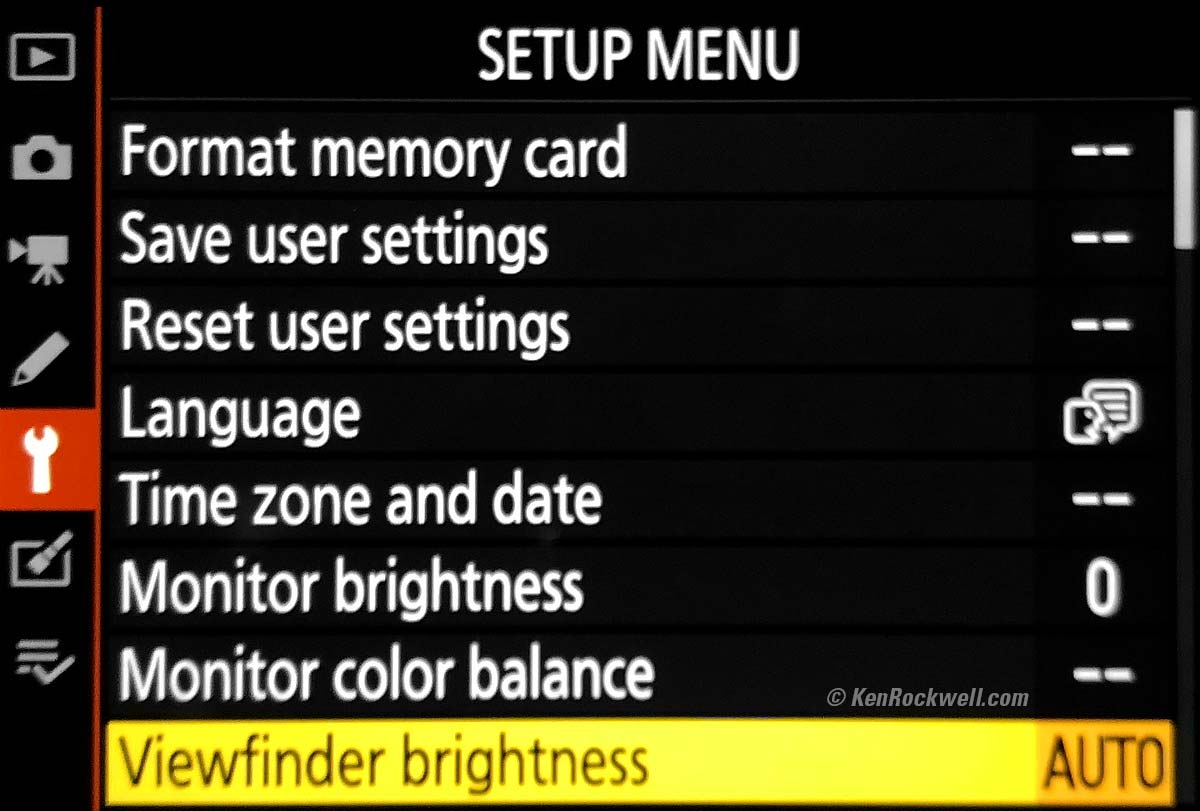 |
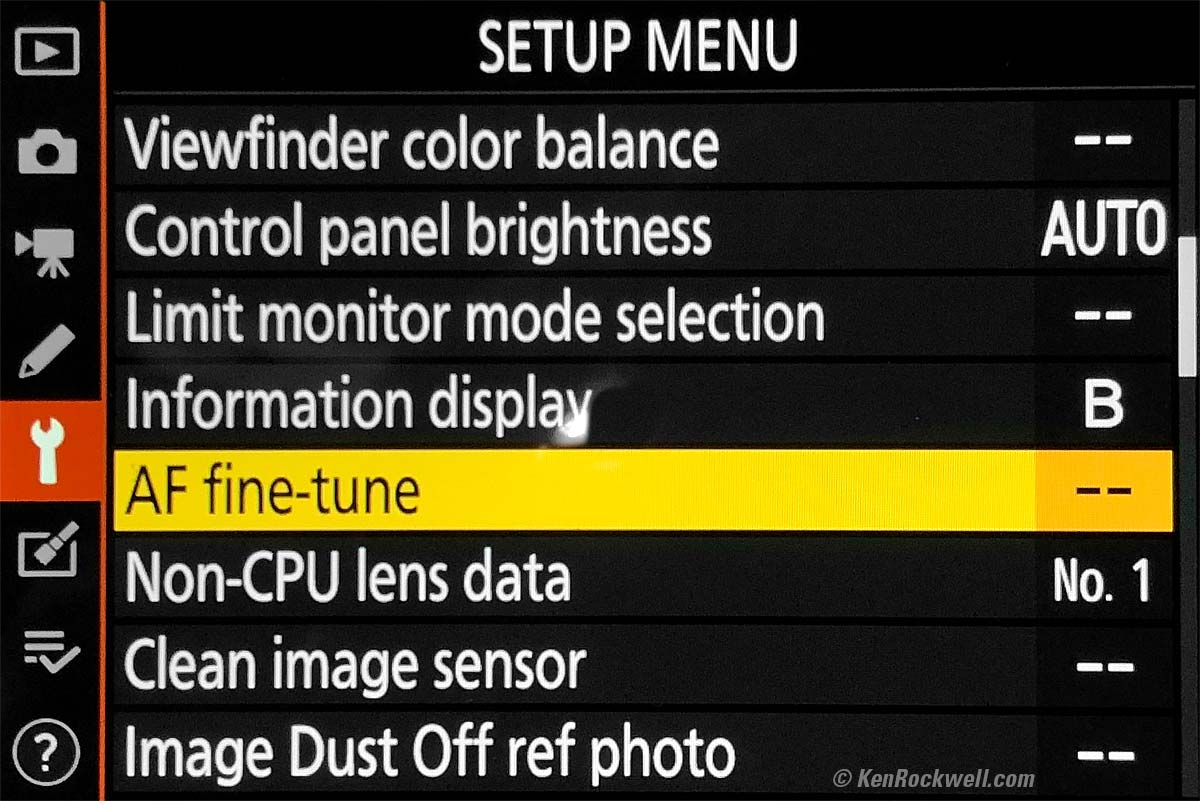 |
Everything looks the same.
Compare this to Sony's menu system, where everything also looks the same, but it's completely disorganized. We never can find anything in Sony's menu system, but Nikon's is well enough organized that it's not too difficult.
Canon's menu system is the best in the business, with expert color-coding and organization and one-click navigation.
Top OLED Display performance top
So long as you're not in direct sunlight, it has automatic brightness control and is superbly legible in any light from daytime outdoors down to starlight:
Top OLED. bigger.
It's almost invisible in direct sunlight because it can't get bright enough. You have to shield it from the sun to read it.
Unlike LCD displays, the top OLED is off whenever the camera is sleeping.
I consider top displays a throwback to 35mm film days, so I don't take these that seriously.
Rear LCD Monitor
The rear LCD is like every other digital camera today.
It flips up 120º and down 45º so it's good for horizontal shots above or below you, but it can't flip side to side and it can't flip 180º for self-portraits.
Playback
Playback is like other Nikons, with the new twist that we can see exactly the same things through the electronic finder as we can see on the rear LCD. Forget the old LCD loupes; just look through the finder and you can see everything big and clear even in direct sunlight — including magnification!
There's a rear 8-way way controller for scrolling around zoomed images and the touch screen works fine for zooming and scrolling.
Typical to Nikon is playback banding in blue skies. It looks the same in the finder or on the rear LCD:
Actual Z7 electronic finder image as seen through the eyepiece (Z6 II is exactly the same). Note banding in the sky. bigger.
It's an in-camera defect only; the images themselves are fine.
It's visible with full-size and reduced playback; it's not visible when zoomed-in and not in the actual images. I suspect it's Nikon playing-back a very data-reduced thumbnail inside each image file for the sake of speed.
Data
Cards are correctly formatted as "NIKON Z 6_2."
JPGs are tagged as 300 DPI.
Vertical images are merely flagged, not actually rotated.
There's an 82 kB junk file called "NC_FLLST.DAT" in each image folder.
Power & Battery
Battery
Battery life is very good, and power management is the best in mirrorless. You can leave the power switch ON and just go about your shooting day; the Z6 II will sleep and wake automatically as it needs to.
Charging
The Z6 II charges from any regular 5V USB port with any random 99¢ USB-C cable. You don't need a fancy charger or cable as you do with Canon.
It draws 467mA charging over the included USB-C cord from a 5V supply.
Better than the old Z6, the new Z6 II includes an MH-25A external battery charger, but you don't need it since you can charge via USB in-camera. This MH-25A external charger lets you charge a second battery while you're charging your first one in the camera.
More at my Nikon Z6 User's Guide (Z6 II is the same).
Compared
Top Sample Images Intro Lens Compatibility
Adapted Rangefinder Lenses Specifications
Performance Compared User's Guide
Z6 II body-only: $1,697 at Adorama, at Amazon, at B&H and at Crutchfield, or about $1,500 used if you know How to Win at eBay.
Z6 II with discounted 24-70mm f/4: $2,297 at Adorama, at Amazon, at B&H and at Crutchfield.
Z6 II with discounted 24-200mm: $2,397 at B&H. (My favorite combo.)
Z6 II with discounted 24-70mm f/4 and FTZ II adapter: $2,447 and at Adorama and at Amazon.
Versus the old Z6
These are the new or different features.
While there are many subtle changes like slightly better high ISO performance (see the High ISO section of each review and see if you can see the difference), the only real differences that matter to me are much smarter autofocus performance that finally works as it should, and having a second card slot.
Nikon vs Canon vs Sony Full Frame Mirrorless Compared.
Nikon Z6 versus Z7.
The Z6 is 99% the same as the Z7, but runs faster for less money.
These comparisons apply the same for the Z6 II versus Z7 II.
Versus Sony Mirrorless
Huge advantages of Nikon mirrorless over Sony are:
 Feels and handles like a real camera, not a VCR as Sonys do.
Feels and handles like a real camera, not a VCR as Sonys do.
 Superior Nikon color rendition. While mirrorless is fun, I get better colors on my Canons and Nikons than I get from Fuji or Sony.
Superior Nikon color rendition. While mirrorless is fun, I get better colors on my Canons and Nikons than I get from Fuji or Sony.
 Full-time instant manual-focus override. A core incompetancy of Sony's and Fuji's systems are that only one lens I've used does this. The rest of the system only can do this part time, only if you set the camera in certain modes, and often the other brand lenses use electronic manual focus which doesn't respond instantly. This Z6 and 24-70Z has manual-focus override that works as it should.
Full-time instant manual-focus override. A core incompetancy of Sony's and Fuji's systems are that only one lens I've used does this. The rest of the system only can do this part time, only if you set the camera in certain modes, and often the other brand lenses use electronic manual focus which doesn't respond instantly. This Z6 and 24-70Z has manual-focus override that works as it should.
Versus Canon Mirrorless
Back in 2018 Canon was ahead, and in the past two years Canon has made huge strides with many innovative new lenses uniquely suited to mirrorless, as well as the world's two best mirrorless cameras — all while Nikon has pretty much done nothing and tried to get us excited about these "II" versions that aren't much different from over two years ago.
I wouldn't spend any more money buying into the Nikon mirrorless system. I'd upgrade to Canon as soon as you can.
User's Guides
See my Nikon Z6 II User's Guide.
Recommendations
Top Sample Images Intro Lens Compatibility
Adapted Rangefinder Lenses Specifications
Performance Compared User's Guide
Z6 II body-only: $1,697 at Adorama, at Amazon, at B&H and at Crutchfield, or about $1,500 used if you know How to Win at eBay.
Z6 II with discounted 24-70mm f/4: $2,297 at Adorama, at Amazon, at B&H and at Crutchfield.
Z6 II with discounted 24-200mm: $2,397 at B&H. (My favorite combo.)
Z6 II with discounted 24-70mm f/4 and FTZ II adapter: $2,447 and at Adorama and at Amazon.
Get this Z6 II instead of the Z7 II. The Z7 II doesn't run as fast, no one needs the Z7 II's extra resolution (24 MP is more enough for anything unless you really are printing 6 feet (2 meters) wide or more) and the Z6 II costs much, much less. See also Nikon Z6 vs Z7, which includes sharpness samples.
The Z6 II is marvelous for nature, landscapes, posed portraits, science, architecture and just about everything. For pro sports the D6 is still king, and for everything else the Z6 II gives great results with much less weight.
Back in 2018 the Z6 was very interesting for nature and landscapes, with its superior handling and color rendition compared to Sony or Fuji. However today in 2020 I can't recommend the Nikon mirrorless system because in the more than two years since the Z system first launched Canon has made huge strides with vastly superior cameras and many brilliant lenses today. Nikon's Z system hasn't gone anywhere except to be offshored for low-cost manufacture, and therefore has fallen more than two years behind. Nikon's newest "gotta have it" cameras are this Z6 II and Z7 II, which are 97% the same as over two years ago.
Nikon lacks the budgets it used to have and I don't see Nikon catching up anytime in the next few years, if ever. I'd strongly suggest upgrading to the Canon EOS R system and not throwing any more money into Nikon. I've owned and shot Nikon every day since 1983, and things have changed. It's not 1983 anymore.
Lenses
Get your Z6 II as a kit with the excellent Nikon Z 24-70mm f/4 S for day-to-day use. It's super sharp, small and compact.
Use the FTZ adapter for your other Nikon lenses, for instance the excellent 28-300mm VR or the 16-35mm VR and/or your choice of telephoto (I use the 28-300mm VR as my telephoto).
Use the FTZ adapter only with Nikon's newest lenses with a built-in AF motor (AF-S and AF-P). These are the only lenses that autofocus with this adapter.
Don't get the FTZ for use with traditional AF-D, AF or manual-focus lenses. Traditional AF-D and AF lenses do not autofocus on the FTZ. Nikon still sells many of these lenses new today, and they work much better on any FX DSLR like a D850. Poo!
Manual-focus F, AI , AI'd, AI-s and adapted rangefinder lenses works poorly on the FTZ with no automatic diaphragm control, poor exposure control, poor finder brightness control and no EXIF or in-finder aperture data — and you have to open-and-close the diaphragm manually for precise focus for each shot!
Flash
The SB-400 is the ultimate mirrorless flash. It works flawlessly with the Z6 II, even turning on and off with the Z6 II's power switch.
Even more than it was on DSLRs, it's tiny as you want on mirrorless, and it's powerful and recycles fast and the Z6 II balances it for fill perfectly.
The SB-400 was discontinued; no worry, you can get them on eBay for under $100 (see How to Win at eBay).
The SB-400 is much better for mirrorless than today's bigger, crummier and more expensive SB-300 and SB-500. The SB300 is bigger, junkier, lower powered and takes too long to recycle from it's pathetic AAA cells, and the SB500 is too darn big and costs more than twice as much for about the same performance as the tiny SB400.
Z6 II body-only: $1,997 at Adorama, at Amazon, at B&H or at Crutchfield.
Z6 II with FTZ adapter: $2,047 at Amazon and at B&H.
Z6 II with discounted 24-70mm f/4: $2,597 at Adorama, at Amazon, at B&H or at Crutchfield.
Z6 II with FTZ adapter & discounted 24-70mm f/4: $2,647 at B&H.
This all content, junk-free website's biggest source of support is when you use those or any of these links to approved sources when you get anything, regardless of the country in which you live. Nikon does not seal its boxes in any way, so never buy at retail or any other source not on my personally approved list since you'll have no way of knowing if you're missing accessories, getting a defective, damaged, returned, non-USA, store demo or used camera. I use the stores I do because they ship from secure remote warehouses where no one gets to touch your new camera before you do. Buy only from the approved sources I use myself for the best prices, service, return policies and selection.
Thanks for helping me help you!
Ken, Mrs. Rockwell, Ryan and Katie.
© Ken Rockwell. All rights reserved. Tous droits réservés. Alle Rechte vorbehalten.
Help Me Help You
I support my growing family through this website, as crazy as it might seem.
The biggest help is when you use any of these links when you get anything. It costs you nothing, and is this site's, and thus my family's, biggest source of support. These places always have the best prices and service, which is why I've used them since before this website existed. I recommend them all personally.
If you find this page as helpful as a book you might have had to buy or a workshop you may have had to take, feel free to help me continue helping everyone.
If you've gotten your gear through one of my links or helped otherwise, you're family. It's great people like you who allow me to keep adding to this site full-time. Thanks!
If you haven't helped yet, please do, and consider helping me with a gift of $5.00.
As this page is copyrighted and formally registered, it is unlawful to make copies, especially in the form of printouts for personal use. If you wish to make a printout for personal use, you are granted one-time permission only if you PayPal me $5.00 per printout or part thereof. Thank you!
Thanks for reading!
Mr. & Mrs. Ken Rockwell, Ryan and Katie.
